Q1 2026
The New Business Context for Leaders
Alex Osterwalder The ambidexterity imperative
The art of reinvention Surviving a disrupted world
In the shadows Explore the hidden depths of your psyche
Banking 5.0 Transforming financial services with AI


Q1 2026
Alex Osterwalder The ambidexterity imperative
The art of reinvention Surviving a disrupted world
In the shadows Explore the hidden depths of your psyche
Banking 5.0 Transforming financial services with AI

How leaders accelerate AI transformation







“This book is essential reading for any leader who is serious about breaking free from legacy thinking. If you want your organization to continuously evolve and thrive, you need to stop being afraid of disruption and start seeing it as the opportunity it is. The Antifragile Organization perfectly captures that shift.”
KEVIN NOLAN, President & CEO, GE Appliances, a Haier company

“The Antifragile Organization explains why top-down command-and control businesses cannot survive in today’s world and describes the kinds of dynamic organizations that are able to navigate the unending change that lies ahead. The book’s diverse examples and well explained principles make it a useful resource for anyone interested in the future of business.”
AMY C EDMONDSON, Novartis Professor of Leadership, Harvard Business School, and author of Right Kind of Wrong: The Science of Failing Well

“In The Antifragile Organization Janka Krings-Klebe and Jörg Schreiner take challenging, complex and abstract concepts and make sense of them in a truly compelling way. Their insights are backed by in-depth and highly practical examples from some of the world’s most progressive organizations. If you are simply interested in organizations or wrestling with managing in complex global corporations, this is required reading.”
STUARTCRAINER, Co-founder Thinkers50


Available through all good book retailers | E-book edition: Print edition: ISBN 978-1-915951-87-8 Published by LID Publishing (


retailers edition: ISBN 978-1-915951-88-5 www.lidpublishing.com)

The debate about AI’s impact on the global economy and society rumbles on. Some contributions could hardly be starker –such as the recent book If Anyone Builds It, Everyone Dies, by Eliezer Yudkowsky and Nate Soares. They argue that continual incremental improvements will, one day, result in an AI being created that brings about humanity’s extinction. It’s an extreme vision – but they’re not alone in warning of AI risks. The industry’s 2023 ‘Statement on AI Risk’ declared that “Mitigating the risk of extinction from AI should be a global priority alongside other societal-scale risks such as pandemics and nuclear war.” Signatories included OpenAI’s Sam Altman and Google DeepMind’s Demis Hassabis – hardly fringe figures in the race to create ever-smarter AI.
Yet, for many executives, the more immediate existential concern is the threat facing their business if they fail to leverage AI quickly. Win the race, and the prizes will be colossal; fall behind, and it could be terminal. However, pitfalls abound. Uncertainty and risk are rife. Failure rates for AI projects are sky high. Leadership needs to adapt for the AI era, and fast. But how?
That’s the challenge at the heart of this issue’s Focus. We start with Duke CE’s Andrés Saint-Jean and his co-author Oseas Ramírez. They dissect the reasons why organizations are struggling with AI, and argue that leaders need to pay more attention to the human and cultural dimensions of change (p16).
Next, Brian Evergreen urges leaders to refocus on shaping a vision for the AI-powered organization – without which, strategy is meaningless (p20). Magnus Lindkvist and Bryan Reimer project AI’s trajectory, from Wow moments to Woah – before genuinely useful applications emerge (p24)
Then, be sure not to miss our interview with Alex Osterwalder, the strategy guru famed for the Business Model Canvas. AI is creating deep strategic uncertainty, he tells Dialogue. The single biggest challenge facing leaders today is building ambidexterity: rebalancing organizations so they can simultaneously explore and exploit (p30).
Elsewhere, Nadya Zhexembayeva offers a thought-provoking guide to reinvention (p36)
Steven D’Souza explores the Shadows: those oftendisowned parts of the human psyche that, left unchecked, can drive damaging behaviors (p44). Kate Lowry reflects on the unwelcome rise of fearbased leaders, and offers practical tips for surviving their hierarchical, cruel ways of operating (p48)
Plus, Diederick van Thiel examines the possibilities for financial services opened up by the combination of AI and behavioral insights (p60).
Audrey Clegg shares critical techniques for thriving in a continually disrupted world – can leaders move beyond permacrisis? (p76) Matthew ButlerAdam and Leela Srinivasan explore the irresistible rise of women’s sports and the leadership that’s driving its growth (p72)
On a different note: we wanted to pay tribute to Joe Perfetti – innovation fellow at Duke CE, adjunct faculty at the University of Maryland, College Park, and Dialogue’s finance columnist – who passed away recently. Joe was a talented teacher, insightful analyst, thoughtful writer, and –above all – a much-loved member of the Duke CE community. We extend our deepest condolences to Joe’s girlfriend, his family, and friends.
In Joe’s absence, we’re grateful to Joseph DiVanna – himself a long-standing Dialogue contributor and Duke CE educator – for his analysis of how the CFO role might change in the AI era, via a wry look at the classic movie, The Wizard of Oz (p59) Are you ready for the AI-CFO?
Enjoy the issue.

Leadership needs to adapt for the AI era, and fast. But how?
Patrick Woodman is editor of Dialogue
Dialogue is brought to you by:
LID Business Media
Editor Patrick Woodman
patrick.woodman@lidbusinessmedia.com
Creative director Kate Harkus
Chief subeditor Luisa Cheshire
Editor-at-large Ben Walker
Publisher Martin Liu
Associate publisher Alec Egan For advertising sales: alec.egan@lidbusinessmedia.com
Duke Corporate Education
Chief marketing officer
Christine Robers
Publisher
Published in the United Kingdom by LID Business Media Ltd, LABS House (5.12), 15-19 Bloomsbury Way, London WC1A 2TH
Disclaimer
Copyright 2025 by Duke Corporate Education and LID Business Media Ltd. All rights reserved. Material may not be reproduced without permission of the publisher. While we take care to ensure that editorial is accurate, independent, objective and relevant for the readers, Dialogue accepts no liability for reader dissatisfaction rising from the content of this publication. The opinions expressed or advice given are the views of individual authors and do not necessarily represent the views of Dialogue This journal is also supported by Knowledge Partners, including Duke Corporate Education as Lead Knowledge Partner. Whenever an author is related to a Knowledge Partner it will be noted as such. Dialogue takes every effort to credit photographers but we cannot guarantee every published use of an image will have the contributor’s name. If you believe we have omitted a credit for your image, please email the editor. Cover image Shutterstock
ISSN 2053-4361
Printed by Paragon www.paragon.world
Editor’s letter Patrick Woodman on leadership in the era of AI 7
Contributors Featured authors in this issue 9
Dialogue Digest The issue’s key themes and topics at a glance
11
Good business Sharmla Chetty on courage in leadership

Alex Osterwalder 30 The big interview Alex Osterwalder, founder and chief executive of Strategyzer
to you to

The power of reinvention New challenges require fresh perspectives
40
Ever forward How DPR
Construction is developing leaders capable of building its future
44
Out of the shadows Unlock empathic leadership
48
Misuse of power The return of fear-based leadership and how to navigate it
52
Find your voice Learn how to swap nerves for notoriety



















Are people cogs in a machine –or the life blood of a living organization?




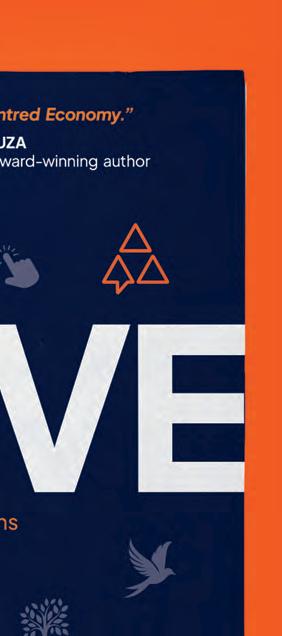

“The bible for the life-centred economy.”
STEVEN D’SOUZA
Senior Partner, Korn Ferry, and author of the award-winning Not Knowing
“The future of work requires us to break free from preconceived notions of how organizations are shaped and managed. Paul’s insights spur us to think about organizations as living organisms, providing a fresh perspective and roadmap to create thriving, sustainable organizations.”
MARY CIANNI
Clinical Associate Professor of Organizational Consulting, New York University
“Just as artificial intelligence threatens to further dehumanize organizations, Alive is an urgent reminder that businesses thrive when they are built around motivated and engaged people. I love the analogy to a living organism –in an era of digital transformation, it brings back into focus the need for humanity at the heart of our organizations.”
STEPHEN GRAHAM
Executive Vice President and General Manager, Hexagon


978-1-917391-13-9 www.lidpublishing.com)


Oseas Ramírez Assad
Andrés Saint-Jean
Global head, strategic partnerships, sustainability and digital, at Duke Corporate Education. Originally from Chilean Patagonia, Saint-Jean has over 15 years’ business transformation experience, leading teams across five continents. He was previously a management consultant at McKinsey & Company, where he was a vice president of McKinsey Transformations, and he forged his early career in the airline industry. Focus p16
Chief executive of Stoic, an AI applied learning company, and a Duke Corporate Education faculty member. A fivetime entrepreneur and former CEO of Axialent, Ramírez previously led global innovation and talent initiatives at Cisco Systems, including the development of internal innovation program Startup//Cisco. Ramírez advises Fortune 500 leaders on AI adoption, innovation, and technology-enabled leadership transformation. Focus p16
Brian Evergreen
Founder of The Future Solving Company, president of The Future Solving Club, and author of Autonomous Transformation: Creating a More Human Future in the Era of AI (Wiley). Evergreen was named by global communications firm Edelman as one of the Top 50 AI Creators You Need to Know 2025, and shortlisted for Thinkers50’s 2025 Radar Award. Focus p20


Matthew Butler-Adam
Regional managing director at Duke CE, leading on culture and transformation initiatives across Europe. Butler-Adam has worked in M&A advisory at Deloitte and as a management consultant with Bain & Company. With master’s degrees from Harvard and Oxford, he brings expertise in leadership, strategy and organizational transformation. Strategy p72


Nadya Zhexembayeva
Founder and chief reinvention officer at The Reinvention Academy (USA). Known as “The Reinvention Guru,” Zhexembayeva is a scientist, entrepreneur and educator specializing in resilience and reinvention. She’s a TEDx speaker, Forbes and Harvard Business Review contributor, and author of The Chief Reinvention Officer Handbook (Ideapress Publishing). Leadership p36
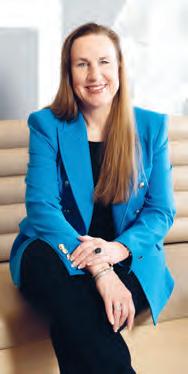
Direct comments, queries and suggestions to media@lidbusinessmedia.com
Audrey Clegg
Chief talent and learning officer at Sanofi. With over 25 years’ experience, Clegg is helping to transform Sanofi into an AIpowered, R&D-driven biopharma leader. As an agile leader, she says, one of her priorities is “to transform the challenges of ‘disruption as normal’ into opportunities to learn and grow.” Strategy p76

Read
dialoguereview.com/download-dialogue-journal-archive/
A quick look at the key themes and topics covered in this issue

Andrés Saint-Jean and Oseas Ramírez Assad examine where leaders are going wrong with AI change efforts, and advise an approach based on co-intelligence – framing AI as a complement to human workforces (p16). Brian Evergreen, meanwhile, emphasizes the central importance of vision for shaping the AI powered organizations of the future. Without it, change efforts are doomed to keep failing (p20).

Alex Osterwalder, founder and CEO of Strategyzer, explains in our Big Interview why corporate leaders need to take a leaf out of the venture capitalist playbook and get comfortable with experimentation, as AI rewrites the rules of strategy and innovation (p30)


Reinvention isn’t academic theory, it’s survival, writes Nadya Zhexembayeva (p36). Steven D’Souza explores the Shadow – the disowned part of the psyche that, left unchecked, can drive damaging workplace behaviors (p44).
AI and behavioral insight can allow financial institutions to create more personalized services and improve access to finance for millions of underserved customers worldwide, writes Diederick van Thiel (p60). Audrey Clegg sets out four crucial techniques that she has developed to lead through an era of strategic uncertainty (p76). Matthew Butler-Adam and Leela Srinivasan shine a light on the rapid growth of women’s sports and the leadership models underpinning its rise (p72)
Fear is inevitable. Yet it can be beaten. It was Nelson Mandela who noted that courage is not fear’s opposite – but the strength that beats it. “I learned that courage was not the absence of fear, but the triumph over it,” the transformative South African president once said. South Africa is the place of my birth, and the location where I quickly learned a similar lesson. All around us are things that scare us: yet bold leaders face into them. Courage in leadership is underrated. But it is imperative if we are to solve the challenges organizations – and the world – face. Courage takes three forms. The first form is imaginative – the bravery to believe that change is possible. Courageous leaders rarely settle with the status quo: they imagine a better future and set out to reach it. Vision is the precursor of all achievement: only those that can envisage change can deliver it. Mandela himself was the embodiment of this, spending 27 years of Apartheid as a prisoner of the state. Yet through that time he was resolute that change was possible.
The second type of courage is disruptive: the determination to identify the obstacles to change – and remove them. This manifests in business as the leader who is willing to speak the truth in the boardroom to change her company for the better. It is the father who tells his daughter that though she looks unlike others at the top table, she belongs there too. It is the colleague who speaks out in their company when unfairness or shortsightedness are preventing talented others from progressing. The third brand of courage is constructive: the courage to build bridges so others can cross. This is harder than it sounds. Organizations – even whole societies – are too rarely built with their doors open. It takes those with power to share that power; to bring others in, to build a table where our daughters and sons sit as equals.
None of these forms of courage seep naturally into our hearts and minds. We must proactively
Business cannot thrive unless societies thrive; societies cannot improve unless businesses lead the way

choose them, go and get them. At Duke CE’s recent Women Leading Change event in Johannesburg, I recalled the 20,000 women who in 1956 marched on the Union Building in Pretoria. They chose the pyramid of courage: the courage to imagine a better world; the courage to disrupt the status quo; the courage to construct the future.
Their race is run; their battle won. But vast societal challenges remain. Organizations have a clear and immediate role in combating the threats of our time. The climate is changing. Inequality is growing. Human rights are under attack. That is why courageous leadership is needed now more than ever. Business cannot thrive unless societies thrive; societies cannot improve unless businesses lead the way.
Dr Sharmla Chetty is chief executive of Duke Corporate Education. She was awarded
the AWCA Woman of Substance award in 2025 for courageous leadership
The easy way to front an organization is to follow it, not lead it: imagine no change, avoid disruption, construct nothing. But the easy route is always deficient in a world that is transforming at speed. Change is often terrifying. But the courageous face into their fear and find a better path.
“It always seems impossible until it’s done,” is a quote best associated with Mandela. It is as relevant now as it ever was. Any idea seems crazy until you make it real. Imagine, disrupt, construct: courage is the key to the future.






















DORIE CLARK Wall Street Journal bestselling author of The Long Game and executive education faculty of Colombia Business School

THOMAS WEDELL-WEDELLSBORG author of What’s Your Problem?






“The best companies want to tap into the full potential of their employees – and that means recognizing the unique needs of morning and evening people. Chronoleadership revolutionizes the way we create inclusive work cultures and equips leaders with strategies for embracing a diversity of chronotypes to improve health, productivity and overall wellbeing in the workplace.”


“With this manifesto against our culture’s time tyranny, Camilla Kring points the way to a brighter future: one where employees flourish, students learn more, and society becomes just a little bit more human. Can we get this revolution started now, please?”



“A must-read for anyone interested in unlocking the full potential of their workforce.”

ALEX WUERFEL Executive Coach and former Vice President at AbbVie Inc.












Leaders must transform organizations into catalysts for connection
You might remember the Ice Bucket Challenge. Or you might not. Because the Ice Bucket Challenge disappeared almost as quickly as it came. In the heady summer of 2014, throwing a gallon of freezing water over the head of oneself or another was en vogue. Some 2.4 million tagged videos appeared on Facebook as the challenge went viral worldwide. A cool $115 million was raised for health charities in that year alone.
Today, shocking your system with freezing liquid might seem an odd way to raise cash for your favorite cause: most folk have reverted to traditional pursuits, like running, cycling or baking cakes. But for a moment, the Ice Bucket Challenge was where it was at: a dare that defined the zeitgeist; a shared experience that gripped the world.
The story tells an important truth about how times have changed. The attention economy is now the echo chamber of our life. The platforms never were the products: the data we generate is where the value always lay. And this has a profound effect on leaders’ roles.
In times past, movements were led by a spearhead – great leaders with the magnetism to spur people to industry, innovation and invention. Today, movements are dispersed, not centralized; quicker to assemble, easier to scale, faster to fade. What once occurred in an eon, now happens in a heartbeat.
Thus, the leaders who will survive – and thrive – are those who command not adulation, but attention. Leadership today is founded on the ability to connect with people on their own terms. In the attention economy, leaders become influencers that can inspire others to find their own way to success, rather than lay the path down in front of them.
The shift to an attention economy has its genesis in the Covid era. Starved of physical
The leaders who will survive – and thrive – are those who command not adulation, but attention
contact with friends and colleagues, people devised new ways to connect. Consider the rise – and subsequent fall – of Clubhouse. Clubhouse was an app in which users were invited to talk in a virtual space of like-minded people. It came and went more quickly, even, than the Ice Bucket Challenge. It was a response to a clear and present need: in a period devoid of connection, characterized by loneliness, professionals found a way to foster a sense of community.
Podcasts have existed since 2004. Yet, similarly, they exploded during the pandemic when people craved companionship and entertainment during isolation. The concept worked – and their appeal has endured.
In the attention economy, people will seek comradeship and connection however and wherever they can find it. It is as true of customers as it is of employees. Where once leaders were the focus of attention, they are now its enabler. Strategy has been replaced by transformation: the need to identify customers’ changing needs, grab their attention, connect with them. Part of leaders’ brief is an emotional audit – gauging the gap between the assets we have and those we need to command the attention of the people we work and trade with. Unlike strategy, which was devised then delivered, transformation is ever-present. It is the new constant.
As the erstwhile fans of the Ice Bucket Challenge might attest, attention can be intense. Yet it is but fleeting. In the attention economy, leaders must renew continually to make a splash.
Vishal Patel is president of global markets at Duke Corporate Education























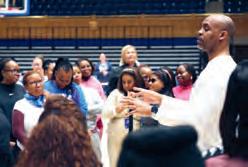




For 25 years, Duke Corporate Education has partnered with organizations across the globe to meet defining moments — and shape what comes next. We don’t deliver off-the-shelf answers. We co-create learning that is custom designed for the challenges organizations face. Whether navigating disruption, building future-ready leadership, or transforming cultures, we walk alongside our clients to fuel purposeful business change — across the globe, at every level.
At the heart of every transformation is a partnership — and every partnership, a story. Let’s shape the next chapter, together.
While artificial intelligence may be advancing at lightning pace, organizational change lags some distance behind. Many leaders are struggling to get out of the starting gates, tripping over the hurdles that present themselves during AI implementation. What sort of leadership is needed to clear those obstacles?
In this issue of Dialogue we look at what leaders need to prioritize to make inroads on AI adoption that truly works for their business. We examine why AI change initiatives keep failing and how leaders can make change stick in a model based on ‘co-intelligence.’ We consider the central importance of vision on AI for driving change. We assess the progress of AI and review how leaders can move beyond the hype to make AI truly useful. And we reflect on what AI-empowered leadership looks like in a world that is dynamic, distributed and data-augmented.
16 Why leaders are failing on AI
20 No strategy without vision
24 From hype to usefulness
28 Renewing leadership for the AI era


“At the end of the day, companies will have to take a process, simplify it, automate it, and apply these solutions. And so, that requires not just technology, but companies to do the hard work of culturally changing how they adopt technology.”
High failure rates for AI projects aren’t inevitable. Here’s how leaders can make change stick
Writing Andrés Saint-Jean & Oseas Ramírez Assad
Across boardrooms worldwide, an uncomfortable truth is emerging: despite vast investment, many AI transformations fail. MIT research shows that 95% of AI pilots never progress beyond the experimental stage. Boston Consulting Group reports that 74% of companies fail to extract meaningful value from AI even after two years of effort.
Yet companies continue to pour vast sums of money into AI. Executives know the technology is essential. What they don’t fully grasp is why adoption keeps stalling.
The paradox is clear. Algorithms are advancing rapidly: technical capability is no longer the bottleneck. The real issue is human. Research consistently indicates that the majority of failures stem from people and organizational factors, including culture, leadership, trust and ways of working – not from code.
Meanwhile, the workforce is under intense pressure. IBM’s 2025 CEO Study suggests that 70% of employees will need retraining within the next three years. The World Economic Forum forecasts that by 2030, more than a third of job skills will have changed. AI adoption is not, therefore, just a technology rollout. It is a wholesale reconfiguration of how people work, learn and collaborate.
Satya Nadella, Microsoft’s chairman and chief executive, captures the essence of the challenge:
AI adoption is a wholesale reconfiguration of how people work, learn and collaborate
This is the crisis many leaders are unprepared for. AI adoption is not a technology project. It is leadership and cultural challenge.
If investment and ambition are so high, why are results so poor? Across industries, the same patterns recur. Integration and alignment are often neglected. One of the most high-profile examples came from IBM’s Watson for Oncology project with MD Anderson Cancer Center. Despite bold promises – and years of investment – the initiative achieved little clinical impact and was eventually shelved. The problem was not the algorithms, but the lack of integration with medical workflows, limited trust among frontline clinicians, and an absence of organizational alignment.
Many organizations also fall into the trap of pilots that never scale. Promising experiments run in isolated pockets of the business – but without changing workflows, incentives and decisionmaking authority, these remain proofs of concept. As McKinsey describes it, there is a “GenAI paradox” at play: AI is widely tried, but rarely embedded into enterprise-wide systems that deliver material value.
Another stumbling block is confusing access with adoption. Companies may invest heavily in tools and run surface-level training on how to prompt AI, but fail to shift behaviors, values and leadership mindsets. AI is introduced as a bolt-on, rather than being integrated into the fabric of how work gets done.
Fear and resistance compound these missteps. Leaders may feel unprepared or overwhelmed, or fear reputational risk if AI systems go wrong. The result is often indecision. Managers fear they will be made obsolete and employees fear redundancy or surveillance. KPMG’s global survey of 48,000 people revealed that a majority of employees either hide their AI use from managers or fail to validate AI outputs, a clear sign of low trust and weak governance.
Leadership misalignment further fragments progress. Boards and executive teams often pull in different directions. Deloitte reports that two-thirds of board members admit to having limited or no knowledge of AI, while only a minority address AI at every meeting. Without clear ownership of strategy, remit and resources, even the most sophisticated tools struggle to gain traction.
The outcome is what some call “AI theatre”: visible prototypes, PR announcements and

innovation showcases that generate headlines but ultimately fail to transform the organization.
The change journey: from fear to co-intelligence
If failures are primarily cultural, then cultural transformation must be the path to success. This is not an abstract idea but a practical shift in how organizations build trust, frame change, and embed new ways of working.
Start by addressing people’s fears – often the most pervasive barrier. Companies that reframe AI as a complement to their people, not a threat, see very different results. Fashion retailer H&M introduced AI in inventory planning and design by calling it “amplified intelligence.” The company communicated that AI would augment human creativity rather than replace it. Employees retained decision-making authority, were trained to experiment, and began to see AI as a tool for exploration. Resistance gave way to enthusiasm, and the business saw measurable improvements in optimization and speed.
Trust is the second critical ingredient. Adoption requires confidence not only in the technology, but also in the ethics and intentions of the organization deploying it. Morgan Stanley provides a compelling example. When the firm launched a GPT-4-powered assistant for financial advisers, initial reactions included skepticism and concern. To address this, the system was restricted to drawing only from verified internal research, and advisers were trained in its capabilities and limitations. Within months, usage rates rose sharply, and what began as a tentative trial became a trusted daily collaborator.
Finally, organizations must move from pilots to systems. This means embedding AI not just in a lab environment but across incentives, workflows and governance structures. Airbus shows how this can work at scale. The company has invested in widespread AI literacy, ensuring its 130,000 employees can collaborate with AI while keeping human decision-making at the center of its processes. By making AI a support system,
Companies that reframe AI as a complement to their people, not a threat, see very different results
not a substitute, Airbus has fostered confidence and accelerated adoption across engineering, manufacturing and customer service.
Similarly, Telefónica recognized that scaling AI required a responsible foundation. The telecoms giant rolled out AI-literacy training across levels, embedded ethical principles into development processes, and appointed ethics champions throughout business units. As a result, AI has scaled across core operations while reinforcing a culture of transparency and accountability.
In each of these cases, success came not from the algorithms themselves but from deliberate cultural design, reframing fear as curiosity, embedding trust, and systematizing adoption across the organization. This is the essence of moving from fear to co-intelligence: creating environments where humans and machines collaborate confidently and productively.
What distinguishes successful adopters is not technology alone but leadership across multiple dimensions, corresponding to the critical areas where organizations must invest if they want AI to stick. The leadership agenda spans six dimensions.
The hybrid workforce Leaders must prepare for new forms of collaboration between humans and machines. This means reskilling employees, clarifying roles and designing workflows where AI augments, rather than replaces.
Trust and ethics AI adoption will stall without trust. Organizations must build governance frameworks that ensure explainability, accountability and responsible use, and then communicate those standards clearly to their workforce.
The culture factor Culture is often miscast as either rigid or soft. In reality, it is the set of behaviors and norms that determine how strategy gets executed. Embedding AI into culture requires tangible levers: incentives, rituals and rolemodeling from senior leaders.
The current high rate of failure for AI transformation projects is less about the technology and its capabilities than about people and organizational factors. Integration is often neglected; access to AI is confused with adoption; promising initiatives fall victim to fear and resistance; and leadership misalignment holds back progress.
Cultural transformation is central to success. It means addressing fears of obsolescence and replacement through clear communication on how AI will be used. Build trust around AI’s capabilities, and the ethics and organizational intentions behind its deployment. And shift the focus from pilots to systems, embedding AI in incentives, workflows and governance structures.

AI-driven decision-making Executives must evolve from instinct-driven leadership to decisions informed by data and AI insights. This requires not only access to tools, but also the discipline to integrate them into boardroom and frontline choices alike.
Scaling adoption Pilots should be designed with scale in mind from the outset, with clear runbooks for integration, measurement and governance. Without this, experiments remain isolated wins.
Future-proofing leadership Today’s pace of change requires leaders to anticipate emerging trends and guide hybrid human–AI teams through uncertainty. That means cultivating adaptability, curiosity and resilience, being open to experimentation, willing to adjust strategies quickly, and confident in leading when the path is not fully clear. Leaders must balance performance with responsibility, ensuring that as AI capabilities expand, their organizations remain both competitive and trusted.
Each of these dimensions represents an essential leadership challenge. Mastering them is what separates those who experiment with AI from those who truly embed it.
To accelerate this shift, Duke CE has partnered with Axialent, a global consultancy specializing in cultural transformation, leadership mindset, and high-performance teams, to design custom learning journeys that help organizations harness the power of AI as a driver of cultural and business transformation.
These are not optional skills: they are imperatives for any leader serious about AI transformation.
The current failure rate of AI transformation projects isn’t inevitable – far from it. Building on the above dimensions, leaders should take six practical steps to improve their chances of success.
1
Reframe AI as cultural transformation
Technology investment will not deliver value unless adoption is prioritized. AI should be treated as a cultural shift, not simply a technical rollout. Leaders who understand this set the stage for enterprise-wide change rather than isolated pilots.
2
Build trust and transparency Employees will only adopt AI if they trust it. That means ensuing clear governance and transparent communication. Trust grows when organizations are explicit about what AI can and cannot do, and when human oversight is guaranteed.
3 Align leadership priorities AI initiatives fail when executives pull in different directions. Boards and leadership teams must align around a shared AI strategy and governance framework. Without this unity of purpose, adoption fragments and progress stalls.
The race to adopt AI is fast-moving, but reckless implementation risks a backlash. Leaders must balance speed with responsibility
4 Empower experimentation Organizations must reward curiosity and create safe spaces for employees to learn and experiment. Broad access to AI tools, reduced procurement friction, and public recognition of wins can help non-technical teams become strong adopters.
5
Balance urgency with responsibility The race to adopt AI is fast-moving, but reckless implementation risks a backlash. Leaders must balance speed with responsibility, setting guardrails that encourage experimentation while protecting the organization from costly missteps.
6
Develop new leadership capabilities
Leading a hybrid workforce of humans and AI agents requires new skills: navigating complexity, fostering collaboration and balancing performance with human well-being. Those companies who are successful at this have shown how deliberate investment in these capabilities enables adoption to spread responsibly and sustainably
Leadership in the age of co-intelligence
Andrés SaintJean, is global head, strategic partnerships, sustainability and digital, at Duke Corporate Education. Oseas Ramírez Assad is CEO at Stoic and former CEO, Axialent
The age of AI will not be defined by algorithms but by leaders. Technology may enable new possibilities, but leadership determines whether adoption sticks. Executives today face a choice. They can continue to invest in technology-first initiatives and risk joining the majority that never realize value. Or they can reframe AI as a cultural transformation: one that demands curiosity, trust, alignment and responsibility.
The organizations that thrive will be those whose leaders consciously design cultures where humans and AI work together – not in conflict, but in co-intelligence.
Most Gen AI projects fail before they begin. Leaders must start developing a clearer picture of their organization’s AI-powered future
Writing Brian Evergreen
In 1951, a leader at Bell Labs called a meeting of departmental leaders and entered the room in a charged emotional state. He grimly announced that the telephone system of the United States had been destroyed overnight. The leaders were confused, as many had used the telephone that morning. He proceeded to restate that the telephone system had been destroyed and anyone who did not believe him by noon would be terminated. He had their attention.
After a long pause, allowing the leaders to process what he had said, he laughed and released the tension. By manner of explanation, he asked the room about the most meaningful contributions to the development of telecommunications ever made by Bell Labs, who had recently been recognized in an article in Scientific American as the best group of industrial laboratories in the world. The answers were unanimous: the dial, which was introduced in the 1930s, but invented in

Transformation is extremely complex and fraught with cultural and systemic inertia
the late 1800s; the ability to transmit multiple conversations simultaneously over one wire, which was introduced between the world wars, but invented in the late 1800s; and the transatlantic cable that connected the United States and Great Britain, which was invented in the 1800s and introduced in 1882.
“Doesn’t it strike you as odd,” the leader said, “that the three most important contributions this laboratory has ever made to telecommunications were made before any of you were born? What in the world have you been doing?” he asked.
“The deficiency,” he continued, “is not yours, but mine. We’ve had the wrong research and development strategy.” The sum of their training and experience had been geared toward maintaining the inventions of others. Even research and development initiatives were focused on achieving operational efficiencies on existing inventions rather than new breakthroughs.

This is, unfortunately, the status quo goal for leaders everywhere. To leave everything better than you found it. To improve parts of the existing system without rethinking or redesigning the whole system. You can spot it in common phrases like “quick wins,” “low-hanging fruit,” and “points on the board.”
The leader at Bell Labs was determined to alter the natural momentum of his organization, so on top of their operational responsibilities, he tasked his team with setting aside dedicated time to redesign the US telephone system, working from the assumption that it had been destroyed beyond recovery. He told them to start from scratch to design a telecommunications system as it ought to be, given the latest technologies and the current economic and regulatory environment.
What ensued was an influx of inventions, including some well-known inventions that became ubiquitous in the late 20th-century, such as
the touch-tone phone, caller identification, and the foundations of cellular technology.
Today’s leaders face a challenge they haven’t been prepared for in school or on-the-job training: the utter necessity of creating and leading with a vision.
This problem spans industries with roots going back to 1911, when Frederick Taylor, the world’s first management consultant, introduced the concept of process engineering in his book The Principles of Scientific Management. In the ensuing century, incrementalism became – and remains –the prevailing form of management.
After an initial breakthrough is paired with a business model and a market that deems a product or service commercially viable, the organization, in order to scale, shifts into a cycle of incremental improvement, never to invent again. New products and services are added, for the most part, not by
invention, but through acquisition. The merger process focuses on industrialization and scale, with incrementalism at its core – driving founders, whose strongest skillset is invention, to retire or exit to start new companies.
Whole careers and markets alike thrived under this model over the last century. The data reflects this cycle: the average Fortune 500 company is 83 years old. Yet the cracks between incrementalism and visionary leadership began to show in the era of digital transformation, as technology companies rose into the Fortune 500; they now represent the top six most valuable companies in the world.
But even in the era of digital transformation, leaders could get by without vision. Incrementalism in moving from analog to digital could yield tremendous results – as it did for most companies.
It’s different with artificial intelligence. Since AI’s reemergence from the second AI winter – the period of reduced funding and research in AI in the late 1980s and early 1990s – leaders have diligently applied the time-honored model of incrementalism. The results are in: 95% of artificial intelligence pilots are failing, as a recent MIT study, titled The Gen AI Divide, suggested.
This is because the successful application of AI, unlike cloud migration, automation, dashboarding, and modernization, requires the organization to fundamentally transform. True transformation is extremely complex and fraught with cultural, economic and systemic inertia, which requires a degree of momentum that only vision can create.
Practices for becoming a visionary leader
Incrementalism is so embedded in our leadership culture that it will likely continue to reign supreme for years to come. Leaders who want to be among the first to replace incrementalism with visionary leadership can start with three practices.
Practice #1 Rethink strategy
Strategy is a cherished word among leaders. Everyone wants to be strategic, and to make strategic decisions and investments. Boards and
Strategy without vision is a misnomer, just like a GPS route can’t exist without a destination
leaders task their teams with creating strategies for AI, for supply chain, or for whatever else is timely and potentially relevant for the future of their organizations.
Teams come together to research and diligently create a combination of analysis and market context, high-level direction, and a plan – a list of tasks, investments and timelines.
Unfortunately, that’s not a strategy. Strategy is the process of creating and selecting decision trees of choices under conditions of uncertainty and competition, with the aim of achieving one’s goals. Rather than a tactical plan of action and investments, a strategy outlines the path between where the organization is and where it would like to be, documenting assumptions to be validated, roadblocks to navigate, and the sections of the path that remain unknown and need to be explored before choices are made.
Strategy without vision is a misnomer, just like a GPS route can’t exist without a destination. A strategy is the route from the starting point to the vision or goal.
Those who are particularly skilled at envisioning the future are often attributed with the gift of vision and genius, like modern-day oracles. Fortunately for leaders everywhere, envisioning can be developed like any other skill.
No rational person, in considering software engineers who have written particularly elegant functions in JavaScript, would assert that some people were just born to write code; that the gods blessed them with innate programming talents. Those developers had to learn the syntax of writing code, theory and practice over weeks, months and years to develop the skill to the point that it culminated in elegant code. This is not to say that individuals do not have natural aptitudes that lend themselves to particular skills – rather, that those skills are not pre-determined at birth, and can be developed well after childhood. The skill of envisioning the future is developed in the same
Management thinking has been oriented toward delivering incremental improvements ever since Frederick Taylor published The Principles of Scientific Management in 1911. Twentieth century markets thrived on this basis – and even in the era of digital transformation, incrementalism in moving from analog to digital could yield tremendous results. But AI requires a fundamentally different approach.
Leadership in the AI era needs to be visionary, starting with three crucial shifts. Leaders need to rethink strategy, creating genuine strategies – guided by vision – rather than tactical plans. They need to start envisioning, developing their skills intentionally. And they need to future-solve rather than problem-solve: starting with a vision and working back to identify the path forward.

manner as the skills of writing software or project management: a combination of theory and practice.
Envisioning is deeply personal, as it necessitates drawing on a person’s experiences and context in order that the vision has relevance for that person, their organization, their industry, or their market. You cannot pay someone else, regardless of their degree of skill in the process of envisioning, to envision your future, or the future of your organization.
Leaders must develop the process of envisioning the future, both individually and collaboratively, if their organization is going to reach, retain or expand a market leadership position and create lasting value in the era of AI. This process of envisioning the future, as opposed to having it envisioned for them by external advisers, also serves as a foundation of mutual buy-in that can sustain momentum when challenges arise.
Envisioning is a vulnerable act of creation – of imagination, distinctively human, and a skill that can be observed under development in any child. For adults, it becomes vulnerable, in that it begins with an admission that the future is unknowable and cannot be controlled – and, like any act of creation, it exposes an individual’s thinking process or line of reasoning to others.
The first step to start envisioning is to create space outside of your operational responsibilities to think. Then, ask yourself what you would create if your company and all its competitors had never existed and you were creating the first company like yours from scratch. Alternatively, start by imagining the announcement of a new product or
service from your competitor: what would make you feel frustrated with yourself or your team for not having thought of it first?
One way to build this skill as a daily habit is to start from the other end in your next brainstorming session or business review. Ask yourself and your colleagues: “What’s the vision that precedes this strategy, this plan, or these tactics?”
There are many ways that you can begin to build the skill of envisioning. The important thing is to start.
Every leader has experienced the inspiring offsite meeting that leads to zero change to the organization. A vision for the future of the company may be created and agreed upon, but when everyone returns to the office they find it does not fit into the organization.
Peter Drucker is famously quoted as having said: “Culture eats strategy for breakfast.” More accurately, incrementalism eats vision for breakfast. If you bring a great vision from an offsite back to a company whose structure, incentives and processes are wired for incrementalism, that vision will not transform the organization without an accompanying shift in mindset.
Incrementalism is rooted in problem solving, which is the craft of getting rid of what you don’t want – but doesn’t help with getting what you do want. For that, you need future solving: the craft of getting what you do want, by starting with a vision and then working backwards to the starting point of today.
Problem solving begins with the question, “What problems should we solve?” The potential answers are infinite. But problem solving, by design, is an act of maintenance, not innovation or creation. When an organization is problem solving, it may be technically moving into the future – but not in a particular direction.
Future solving begins with the question: “What ought to be?” followed by: “What would have to be true for us to achieve this?” It means working recursively backwards until the entire path has been mapped – from where you are, to the future you want to create.
Brian Evergreen is founder and CEO at The Future Solving Company, president at The Future Solving Club, and author of Autonomous Transformation (Wiley)
Make no mistake: this is a new way of doing strategy, making it visual, creating clarity, and forming a foundation for a more scientific way of making decisions.
We are on the brink of a new era, with sweeping implications for the future of work and society. There has never been a greater need – or opportunity – for leaders to boldly step forward to create and lead with vision.
new shapes. Seventeenth century tulips and this century’s subprime mortgages were pure bubbles. When they burst, vast sums were wiped out and nothing useful remained.
But other manias leave behind infrastructure. The railroads of the 1800s and the dot-com crash of the 1990s destroyed fortunes but left train tracks, fiber-optic cables, and a new way of imagining the future. Companies vanished, but the ideas of train travel and internet surfing remained.
Avoid being distracted by overinflated claims about AI’s potential and focus on these practical steps to make AI work for you
Writing Bryan Reimer & Magnus Lindkvist
There’s a specter haunting the business world – the ghost of artificial intelligence (AI). Like one of those 1980s TV shopping infomercials, AI is accelerating valuations and promising to boost revenue. It will blow away boring tasks in a gust of air, while making you dramatically more productive – if it doesn’t steal your job, that is.
And why stop there? It promises to discover new chemical compounds, compose music that makes you cry, and cure every disease known to humankind – if it doesn’t destroy the world outright, of course.
The hyperbole seems unlimited. Yes, it’s a stock market bubble, and you’ve likely already missed the best part of Nvidia’s stock surge. And no, there aren’t any innovative AI thought leaders or Python programmers whom you can poach to transform your company into an “AI-first” enterprise overnight. But here’s the thing: AI is not just a bubble. It’s a balloon.
The AI balloon
A bubble pops and disappears completely. A balloon can deflate, but it can also be reinflated in
AI is not just a bubble. Itʼs a balloon that can be reinflated in new shapes
The current electricity-guzzling, capexswallowing iteration of AI is likely to end in tears for many investors. But the underlying capability –automating routine tasks, processing text and data at lightning speed – is here to stay. The challenge for leaders is to look past the hype and think about the long-term potential of AI, and the steps they can take to realize it.
One of the most important points to grasp about AI’s spread is that it is not a utility. Utility emerges slowly, unevenly, and often by accident. But technology evolves at the pace of Moore’s Law – exponential, feverish, out of sync with nearly everything human, from learning to lawmaking.
Think of the New York Electrical Show a century ago. Electricity was the new thing, showcased in gadgets like vacuum cleaners, lamps (clunkily dubbed “electrical vase light attachments”), and speculative oddities like bathtubs full of bulbs and radio direction finders. In the early phases, new technologies are always gadgets – before the real value becomes clear.
One of electricity’s most transformative uses wasn’t obvious at all: the electric guitar. The Rickenbacker ‘Frying Pan’ arrived 15 years after electricity was mainstream, but for its first decade, it was strummed like an acoustic guitar. Then Sister Rosetta Tharpe cranked her amplifier too far and the screech of feedback was born. That sound changed music forever – not because of engineers, but because of an outsider with no rulebook.
And that’s the pattern. Utility comes later, often by accident, and often through outsiders. Think about the transformation of the World Wide Web, from a stock market bubble to a transformational utility.
In November 2000, amid the wreckage of the dotcom crash, Amazon hosted a recruitment event in Stockholm’s Vasa Museum – home to a giant warship that sank 1,400 yards into its maiden voyage. The symbolism was potent.
Most people thought Amazon was just a bookstore. Jeff Bezos, a nerdy hedge-fund programmer, had no retail pedigree. Pets.com















































































































and Boo.com had collapsed into punchlines. Yet Amazon survived – because it wasn’t really about books. It was about customer obsession. What if anything you wanted could arrive at your doorstep at the click of a button – or better, before you even asked?
The same pattern repeats. Apple wasn’t a phone company. Spotify wasn’t a record label. Shein’s founder, Xu Yangtian – unlike the founders of H&M or Inditex – had no experience in clothing or tailoring. He was a specialist in search engine optimization. Outsiders without legacy constraints redefined industries.
AI will follow the same path, with change led not by those bound by dogma – “This is how we do things around here” – but by outsiders who ask new questions.
So, what exactly are the questions we should be asking ourselves about AI’s new tricks?
What AI can and cannot do AI is not magic: it processes vast amounts of data, ranks patterns, and makes probabilistic guesses about what comes next. Everything it does, a human can do too – but AI does it faster. Modeling a single protein might take a human researcher months, but AlphaFold, the Nobel Prize-winning AI system, can do it in minutes.
Think of AI as a cognitive power loader. Just as machines let us lift heavy objects quickly, AI helps us accomplish far more with less. An architect can generate dozens of blueprints in an afternoon. A lawyer can scan thousands of contracts in minutes. A doctor can compare a scan against millions of images in seconds.
This forces us to confront a hard truth: many professional barriers are social constructs. Becoming a doctor takes decades – primarily due to the regulatory process, rather than innate ability. A 17-year-old can drive a Formula 1 car; a 12-yearold can land a 747 in Flight Simulator. Avicii made global hits with nothing but a laptop. Soon,
Think of AI as a cognitive power loader. Just as machines let us lift heavy objects quickly, AI helps us accomplish far more with less
a teenager will create the world’s most-watched movie using free AI tools.
We confuse societal habits – and the legacy thinking and regulatory frameworks they create – with reality. When we talk about disruption, it is merely an observation that technology can cut through and clarify these gaps in our assumptions, drastically changing the landscape for law firms and movie studios alike. That doesn’t necessarily mean we will roll out the red carpet for all things AI.
In the early 2010s, we thought social media would end wars and erase borders. YouTube was supposed to deliver world-class teachers to every child from Botswana to Bradford. A decade later, schools are banning smartphones, and countries are restricting social media for kids. What happened?
Technologies follow what Gartner calls the Hype Cycle: from the peak of inflated expectations to the trough of disillusionment. Or, as we put it: from Wow! to Whoa!
AI’s Wow phase is dazzling. Summarize 10,000word articles instantly! Write code in seconds! Draft essays, contracts, cover letters!
But the Whoa phase is sobering. AI threatens the very systems it enhances. Students can generate essays as easily as teachers can grade them; job applicants fire AI-written CVs at AI-driven recruiters. And regulators will not sit idly by. Technology doesn’t beat jurisdiction – it collides with it. When governments realize that AI undermines education and credentialing – and the labor pipelines they were designed to protect – a backlash is inevitable.
Universities that rely on degrees as gatekeepers, unions that defend long training paths, and industries built on billable hours will all push back – not necessarily because the technology doesn’t work, but because it works too well. We’ve seen this before: taxi lobbies fought Uber, record labels resisted Napster, and governments have tried to regulate and shut down social media. The pattern repeats. AI’s Whoa phase will not be about whether it can summarize, code, or diagnose – it will be about whether society is willing to let it.
But the AI backlash isn’t a verdict on the technology. It’s the design brief for what comes next.

In 1888, Bertha Benz set out on a 100-kilometer journey in her husband Karl’s prototype “horseless carriage.” There were no petrol stations, so she bought ligroin – a petroleum-based solvent – from a small-town pharmacy. The car broke down repeatedly, forcing her to improvise roadside repairs. Hills proved nearly impossible, inspiring
the later addition of a third gear. What looked like a stunt was really a stress test. By enduring a messy, unglamorous trip, Benz helped turn her husband’s fragile invention into something practical.
Her journey shows us something essential: invention isn’t enough. Technology has to prove itself in the real world. The automobile wasn’t ready for the world, and the world wasn’t ready for the automobile – until both evolved together.
AI is now in its own Bertha Benz moment. The Wow phase dazzled us. The Whoa phase exposed cracks: lawsuits over data scraping, environmental strain, unreliable outputs, digital pollution and performance decay. These flaws invite criticism and resistance – but backlash is not the end of the story. Automobiles needed roads and rules. Electricity needed grids and standards. AI now needs safeguards, governance and better fits with human systems.
This is the Grow phase: the patching, iterating, duct-tape stage where messy trials lead to lasting improvements. AI doesn’t yet replace professions wholesale; instead, it slips tactically into tasks where risks are low and benefits are clear. Step by step, like Benz’s improvised journey, those patches accumulate, building trust, legitimacy and momentum.
What does this mean for business leaders? It means your role is not to wait for AI to arrive fully formed, but to create the conditions where it can be tested, patched and improved inside your own organization. Just as Bertha Benz exposed the missing gear, your pilots and experiments will reveal the gaps where workflows, governance and expectations need to adapt. The lesson is not to adopt everything – but to adopt thoughtfully and strategically, finding the places where AI can act as an equalizer (raising the floor) or amplifier (raising the ceiling).
The leaders who succeed in this phase will not be those chasing hype, but those willing to endure the unglamorous, Bertha Benz-style road tests that turn fragile prototypes into transformative systems.
Today, leaders aren’t driven only by fear of missing out (Fomo). They’re equally driven by fear of f***ing up (Fofu). AI is not a bubble that will vanish; it’s a balloon that will deflate, reinflate, and take new shapes. The question for leaders is not “How fast can I learn the new tools?” but “What am I willing to unlearn so that AI can become useful here?”
Throughout history, progress has depended less on embracing the new and more on discarding the old. Electricity only transformed the world when people unlearned their reliance on old appliances and reimagined what power could do – like
A balloon, not a bubble
AI’s impact may be over-hyped and AI-related stocks may be over-valued – but AI is not a bubble that will burst and leave little behind. Rather, it is a balloon that can be reshaped and repurposed. For now, AI largely takes the form of gadgets, with relatively trivial applications; its real value will emerge over time.
wow, to woah, to grow
AI is set to follow the same trajectory as many new technologies. At first, it looks impressive, albeit of uncertain value. Next comes the backlash – which will signal where refinements are needed. The end goal is growth – making AI truly useful by unlearning old habits, questioning assumptions, and embracing trials.
Your role is not to wait for AI to arrive fully formed, but to create the conditions where it can be tested, patched and improved
creating the electric guitar. Amazon didn’t succeed because it mastered bookstores, but because Bezos unlearned retail dogma and redefined what shopping could mean. Demis Hassabis, the creator of AlphaFold, won the Nobel Prize in chemistry despite – or perhaps thanks to – not being a chemist. Bertha Benz didn’t wait for perfect conditions; she unlearned the idea that roads, fuel and repairs had to already exist. By testing the car in the real world, she revealed the missing pieces that made automobiles practical.
AI today is forcing us to unlearn assumptions about professions, credentialing, and workflows – showing that regulation and habit, not just capability, shape what counts as work. To lead in the Grow phase requires building an unlearning organization. Such organizations do four critical things.
Question inherited assumptions about education, careers, regulation or “the way things are done”
Embrace messy, imperfect trials, patching and iterating rather than waiting for flawless solutions
Treat AI as both equalizer and amplifier –raising the floor for novices while giving experts new leverage
See backlash as feedback, not a verdict, and use it as a design brief for adaptation
Dr Bryan Reimer is a research scientist at MIT. Magnus Lindkvist is a futurologist. They are the authors of How to Make AI Useful: Moving Beyond the Hype to Real Progress in Business, Society and Life (LID Publishing)
The leaders who thrive will not be those who adopt AI fastest, nor those who resist it longest, but those who unlearn and relearn with courage. They will take prototypes out of the lab, expose the flaws and adapt. In the end, usefulness does not come from hype or fear – it comes from the willingness to let go of what no longer serves, and discover what might.
As organizations encounter novel pressures, new leadership capabilities will become mission-critical
Writing Mika Ruokonen
Today, that model is breaking. AI systems can now simulate futures, personalize communication at scale, and detect weak signals far faster than human teams. Modern leadership requires constant real-time adaptation.
One example of this shift is Siemens. The company has enhanced its predictive maintenance platform with generative AI, enabling faster, more intuitive maintenance decisions through conversational interfaces. This integration helps the company respond proactively to equipment issues, boost productivity, and bridge workforce skill gaps, supporting real-time operational agility.
A similar shift is already visible in many forward-looking organizations. Instead of waiting for problems to escalate, leaders are using AIpowered dashboards to preempt disruption. Strategy isn’t a binder reviewed once a year, it’s a living system fed by data and updated continuously.
Three pillars of AI-empowered leadership
So what does this new model of leadership look like? In my work with firms across industries, I’ve found three emerging pillars.
Predictive awareness
Leaders must shift from relying on hindsight to cultivating foresight. Thanks to AI and data analytics, it’s now possible to detect early signals of change, whether in customer preferences, market trends, competitor moves, or internal dynamics like employee engagement.
Artificial intelligence isn’t just changing tasks; it’s redefining what it means to lead. For decades, leadership was defined by experience, intuition and scheduled strategy cycles. Decisions were made top-down, often based on lagging indicators. But today, AI is accelerating everything: information flows, decision windows, customer expectations and human cognition.
This shift isn’t a passing trend. The AI revolution is a structural transformation, likely to unfold over the next two decades. As generative models, predictive analytics and data augmentation become embedded in everyday work, leaders must ask a new kind of question: How do we lead when machines also think, anticipate and recommend?
Traditional leadership models were designed for predictability. In the industrial era, decisions were centralized and slow. Leaders reviewed performance quarterly, updated strategy annually, and adjusted course reactively.
Artificial intelligence isnʼt just changing tasks; itʼs redefining what it means to lead
JPMorgan Chase, for instance, uses advanced AI tools to detect emerging client needs early – a smart approach that helped the bank boost sales and attract new clients during recent financial market volatility.
This elevated situational awareness allows leaders to spot risks and opportunities before they fully emerge. Awareness becomes a strategic asset, enabling leaders to see around corners.
Awareness alone isn’t enough: what defines modern leadership is the ability to respond quickly and precisely. With AI surfacing insights in real-time, leaders can shift from static, scheduled planning cycles to fluid, adaptive execution in the moment.
Procter & Gamble has transformed its supply chain by integrating AI, automation and real-time analytics, enabling rapid, flexible responses to market disruptions and inflationary pressures. This agile approach supports the company’s focus on quality and operational resilience.
AI can instantly generate simulations, recommendations and tactical options –eliminating the need to wait for quarterly reviews,

and enabling immediate adjustments to operations, priorities and communications. Strategy becomes a living process, updated continuously.
AI makes it possible to tailor leadership itself. From communication style to coaching, from team design to workload balance, everything can be customized based on real-time data. The same is true for customers: segmentation is becoming obsolete, replaced by granular personalization. Deloitte leverages AI to enhance employee experience by using human-centered design to understand employee needs. Their approach includes tailoring learning and development programs to individual employees, thereby improving engagement and retention.
Leadership moves from ‘one-size-fits-all’ to ‘one-size-for-you.’
What stays human
AI augments leadership, but it doesn’t replace it. Good leadership still requires empathy, ethics,
storytelling, and vision. AI can support those skills but not substitute for them.
Microsoft, under chief executive Satya Nadella, has reshaped its culture around empathy: not just as a human value, but as a strategic lens for innovation, inclusion, and customer understanding. Nadella sees AI as an enabler of better human judgment and deeper connection.
It is also good to remember that some decisions still require human deliberation: hiring executives, entering new markets, acquiring companies, navigating ethical dilemmas. Leaders must learn when to lean into AI and when to say no.
Crucially, leaders must avoid turning AI into a surveillance mechanism or a hollow optimization tool. Employees notice when tech feels dehumanizing. Poorly implemented AI can backfire, eroding trust and engagement.
Boeing offers a cautionary example. The company piloted an AI-driven monitoring system using sensors and cameras to track employee presence and desk-usage, but quickly scrapped the initiative following an employee backlash over privacy concerns, acknowledging its negative impact on trust and morale.
Examples like this show that how AI is implemented – not just whether it’s used –determines whether it builds or erodes trust.
As organizations encounter new pressures, new skills are required. The leadership toolkit is expanding. Three capabilities will be crucial for tomorrow’s leaders.
Understand data and algorithms: not to code, but to ask better questions
Translate AI-generated insights into actionable strategy
Build hybrid decision processes where humans and AI complement one another.
Most importantly, leaders will need to foster cultures of learning, speed and experimentation. The real challenge isn’t technology, it’s transformation. When implemented with care, AI has the potential to ease leadership burdens, shifting focus from constant firefighting to a proactive, human-centered strategy. That’s the paradox: as AI makes leadership more complex, it also opens space to make it more human.
Mika Ruokonen is industry professor of digital business at LUT Business School
In leading companies, this transformation is already happening. Others are just beginning. But the direction is clear: leadership in the AI era is dynamic, distributed and data-augmented. The most adaptive leaders won’t resist the shift. They’ll shape it. And in doing so, they’ll redefine leadership for the next era of business.
large company, and I found that fascinating. I was interested in business – in what business is.”
That curiosity was to inform Osterwalder’s educational choices – although his path took some unexpected turns. “I failed at business school, then did political science. But, competitive as I am, I went back to business school and did a PhD,” he laughs.
Ambidexterity is imperative as leaders grapple with the implications of AI
Writing Patrick Woodman & Vishal Patel
How far will artificial intelligence impact your business this year? What about over the next three years? Today, leaders face few challenges as urgent as adapting to the emergence of AI and adopting it in their organizations. From delivering a step change in process efficiency and productivity, to turbocharging innovation, to ripping up established business models and making possible entirely new ones: the potential for AI seems near-endless.
But how can organizations make sense of an inherently uncertain and fast-changing picture? As leaders attempt to chart a path forward, one of the most insightful thinkers they might consult is Alex Osterwalder, founder and chief executive of Strategyzer.
Osterwalder is ranked at #8 in the Thinkers50 list of management thinkers – jointly with Yves Pigneur, with whom he developed the Business Model Canvas and Value Proposition Canvas tools – and famed for his work on innovation and strategy. We connected with Osterwalder to discuss the transformative challenges facing leaders today – and his own journey in leadership.
Human constructs
Osterwalder’s passion for business began to emerge in childhood, although his is not the familiar story of entrepreneurs who started by selling to their schoolfriends. “My dad was a senior leader in a
Political science taught me the world doesn’t have to be the way it is. Business models don’t have to be the way they are
The decision to study political science proved pivotal, reigniting his interest in how corporations function. “Political science was the best thing that could have happened to me,” he explains. “At the University of Lausanne, several professors had sociological views of politics. They drilled into us that institutions and society are the way they are because people built them. That helped me later to question everything, including the so-called ‘laws’ of business.
“Steve Jobs talked about this,” he continues. “Everything around you is man-made – and changeable. It’s up to you to create.” This is a critical truth for any leader seeking to transform their organization. “Political science taught me the world doesn’t have to be the way it is. Business models don’t have to be the way they are.”
Osterwalder’s father had also sparked an interest in computing when, in the 1980s, he brought home an early DOS-based PC. He left his son to experiment, igniting an interest in programming and technology that, years later, influenced Osterwalder’s decision to embark on his PhD in management information systems – supervised by Yves Pigneur. It was the start of a productive and enduring relationship – but it almost didn’t happen. “I did a pre-interview with McKinsey but they didn’t want me,” recounts Osterwalder. “I got lucky with that failure!”
Osterwalder’s studies led him to develop the Business Model Canvas, a tool for exploring the nine components of how any given business creates, delivers and captures value. It was presented in his 2010 book with Pigneur, Business Model Generation – with the Value Proposition Canvas outlined in 2014’s Value Proposition Design
Those tools have become boardroom staples, helping executives build clarity about the central fundamentals of their business – a task that is more relevant than ever as organizations grapple with AI.
In Duke CE’s conversations with C-suite leaders, the difficulty of distinguishing signal from noise around AI is a recurring theme. Osterwalder has observed the same in his discussions with leading global firms. “The current uncertainty is forcing leadership to think about innovation,” he reflects. “Before, they could get away with not doing it; now, that’s harder, both because of uncertainty and because of the technological opportunities.”

This points to a fundamental truth. “It’s not a technology problem. It’s a business challenge. How do you do innovation? How do you de-risk?”
While running Strategyzer accounts for much of his time, Osterwalder has recently been spending more time in the field with clients – and he sees many companies approaching the challenge from the wrong direction. “I work with some clients who are really into technology, and they forget that it’s actually about the value proposition for clients. It’s so simple – but when you’re a big corporation, you can lose sight of that.”
Refocusing on the fundamentals of the business model – on what a business does for its customers – is critical. “Going back to basics is so important right now, and so powerful,” he says. He explains how organizations can lose their way. “Every startup or innovation starts with an idea – a technology, patent, opportunity, asset. You search for a solution – product, value proposition, business model. Once you find it, you scale; it becomes a management challenge.”
The problem is one of over-tilting toward management of an established model. Here lies the fundamental shift required of leaders today: rebalancing the two modes of business, “explore” and “exploit.” Entrepreneurs and creators explore; large corporations are optimized to exploit. “I’m working with senior leadership teams at of some of the biggest companies in the world right now, and this is the big theme: balancing explore and exploit,” he confirms. “These large companies were startups once, but they forgot how to create. They became execution machines. They have to rediscover how to create.”
This is not a new idea, he notes. “Academics have been writing about the ambidextrous organization for ages, but they haven’t really popped up that often, with a few exceptions like Amazon.” But AI means the idea is impossible to ignore. “What gets me really excited is that this has leadership consequences,” he continues. On the exploit side of the ledger are the traditional management questions: is work done on time, on budget, and with robust project management? With explore, the questions are very different: What did we learn? Should we kill the project?
“Here’s the thing,” he adds. “I show senior leadership teams how these two worlds, explore and exploit, are different. What I’m constantly fascinated by is that these are very, very intelligent people running multi-billion dollar businesses –yet such a simple concept can blow their minds.”
How is this explained? Most C-suite leaders lack entrepreneurial instincts or experience, says Osterwalder: they spend their careers running businesses, before taking the top seats in the biggest companies. One exception is Bracken Darrell, the

The CEO who’s good at running a business, has a vision of the future and is entrepreneurial will out-compete the managerial CEO
former CEO of Logitech (now of VF Corporation). “He’s an entrepreneurial CEO who understands that those two worlds are different. He can toggle between the two mindsets,” says Osterwalder. That is a clear competitive advantage. “I think we’re going to see this more and more often: the CEO who’s good at running a business, has a vision of the future and is entrepreneurial will out-compete the managerial CEO.” That’s not to say that core management capabilities are obsolete. “You can never compromise on running the business. You can’t innovate yourself out of a hole. But you need both: you need that ambidexterity.”
One of the central tasks involved in building an ambidextrous organization is changing how resources are allocated. Learn from venture capitalists, says Osterwalder: they create a funnel for their investments, making lots of small bets while knowing only a few will pay out. This is critical for AI adoption, where big bets on unproven use cases could be ruinous. “Some executives say, ‘I need to put $10 million, or $100 million, in one AI project.’ That’s the best way to burn money! What you want to do is take $10 million and spread it over 100 projects – then after three months, kill 50% of the projects. That’s what the venture world does really well.”
Big bets can work in a crisis, he points out. When digital technology destroyed the traditional
photographic film business, Fujifilm pivoted to cosmetics, applying their IP to skincare. “They had to bet the farm, because they had no time,” notes Osterwalder. “But in general, that’s the best way to maximize your risk of failure. The best companies experiment all the time, systematically building up a portfolio approach.”
The fact that many firms still make big bets drives perhaps the biggest myth about innovation – that it’s too costly. “People say it’s expensive and risky. Well, if you make one bet, it’s like roulette –but if you work like a venture capitalist, you spread your bets and you let the winning ideas emerge. Leaders think, ‘I need to pick the best idea,’ but nobody can do that – not even venture capitalists. So you manage risk by spreading your bets.”
The strategy is well-proven yet it clashes with how corporations operate. “We’ve optimized for running the business and killed all the exploration,” points out Osterwalder. “I call it the ‘corporate antibodies.’ Anything that looks different is killed too early, so companies can’t explore.” It’s akin to an allergic reaction: the body corporate is destroying the very thing it needs most for long-term vitality. We tend to lionize innovative leaders for their creativity, but other qualities matter more. “Creativity is overrated. People who believe in ideas will always fail, because innovation is not about the idea. The hard part is iterating the idea until it works,” says Osterwalder. That makes decisionmaking key, starting with understanding the type of decision at hand. Jeff Bezos famously talked of oneway and two-day doors: irreversible and reversible choices. “There are decisions where analysis matters – you’re making a big bet and you have to think hard. That’s the execution type of decision,” says Osterwalder. With two-way doors – those small bets – it’s different. “Don’t think, just go and do. Experiment, experiment, experiment – knowing that half of the things you try won’t work, and that’s OK.”
Amazon has long stood out for its innovative capability, which has helped it create entirely new business models such as Amazon Web Services. Compare Google, which has successfully iterated its advertising business model, without building entirely new business models to the same extent.
Lessons can be learned from Chinese conglomerate Ping An, says Osterwalder. It grasped the need for different approaches to explore and exploit, and appointed Jessica Tan to head the explore side – with the title of co-CEO. That was significant. “The biggest challenge for innovation is usually the lack of power,” says Osterwalder. “What gives you prestige in most companies? The number of people you manage and the budget you have.”
The conundrum is that innovation, by its nature, starts small – and small initiatives don’t win attention in a corporate environment. “We have

2010–Founder and CEO Strategyzer
2008–Speaker, author, adviser Alex Osterwalder Facilitation
2022–Visiting professor IMD
2006-2008 Partner Arvetica
2004-2006 Founder and owner
Businessmodeldesign. com
2004-2006 Strategy development and implementation
The Constellation for AIDS Competence
2000-2005
Senior research fellow University of Lausanne
to make these tiny explorations sexy again. That’s what serial innovators are really good at – they give prestige to exploration.” They’re also consistently focused on customers, he adds. “Technology is a means to an end: it’s about creating value for customers, with value propositions embedded in scalable business models.”
The great accelerator
We turn back to the specific challenges around AI. The innovation process will be accelerated. “You can prototype a value proposition, use agents to do customer interviews – with real people or synthetic users – and stress-test a concept within a day,” he says. That changes the equation for success. “My hypothesis is that exploration is going to trump exploitation in an AI-first world,” argues Osterwalder. “Innovation culture is going to become more of a competitive advantage than the actual products and technologies. The ability to constantly reinvent yourself is going to be the key competitive advantage. We’re already seeing this.” That spans every type of innovation – efficiency, sustaining and transformative, to adopt Clayton Christensen’s categories. Leaders need to consider where their efforts are focused. “You can use AI to improve your business model – but if your business model is dying, you’re just going to die more efficiently,” jokes Osterwalder. So where do leaders start? “The first thing I suggest is increasing your ability to experiment, because with AI, like with any innovation, we don’t know what’s really going to work.”
All options should be on the table. “You can use investments, intrapreneurial teams, M&A, open innovation, doing it inside or outside – use every part of the innovation toolbox,” he advises. “But the mindset – the philosophy – is the first thing to get right.” The playbook for building an innovation culture can also be codified, he suggests. “There’s the formal stuff: What do I pay people for? Do I pay them to execute, or do I give them time and money, and reward them in the 360, for exploration?
Then the less formal part is how leaders behave in innovation meetings. Do they insist on a business plan, or do they ask, ‘What’s the evidence?’ It’s not rocket science, but it’s hard to deploy this at scale.”
Business schools have a role to play, too. They have long focused on perfecting Management 101, we suggest: prioritizing exploit over explore. Osterwalder is emphatic. “They are not educating leaders to create the ambidextrous organization: it’s a side topic when it should be the core.”
Vishal Patel is president of global markets at Duke Corporate Education. Patrick Woodman is editor of Dialogue
As AI transforms our world, starting with our businesses, the challenge will be existential. “Ambidextrous companies are the only ones that are going to survive in the long term,” says Osterwalder. Leaders ignore his analysis at their peril.



















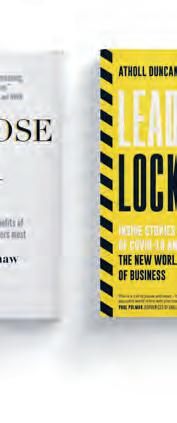



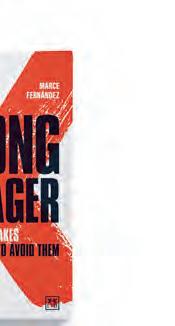






































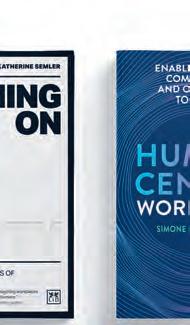

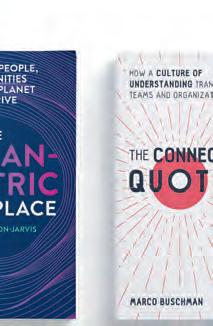






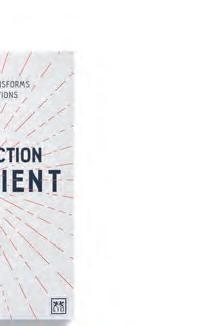
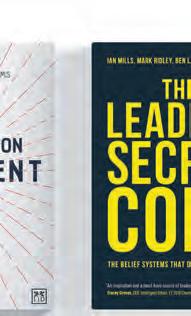











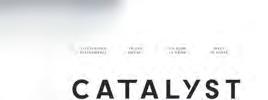


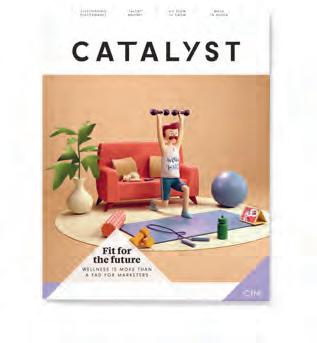












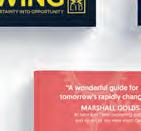























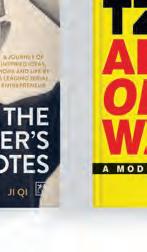





Surviving in a continuously disrupted world requires curiosity and adaptability
Writing Nadya Zhexembayeva
Inever thought a five-year-old could teach me something profound about leadership. But there I was in Venice, asking my daughter Lila what she remembered most from our walking tour. While adults spoke of gondolas and Venetian gothic architecture, she had a different perspective entirely.
“Butts,” she said matter-of-factly.
After confirming that I had heard her correctly, Lila explained her answer with perfect logic: “I am very short, mom. And the streets are narrow and jam-packed with people. So all day, I kept staring at many, many butts. That’s all.”
While we were experiencing Venice, she was seeing something completely different. This crystallized something I’ve been witnessing across boardrooms worldwide. Leaders are trying to

sell their teams “Venice” – beautiful visions of the future, inspiring strategies, transformational initiatives. But their people are stuck staring at the equivalent of butts – endless disruption, constant pivoting, and the exhausting reality that nothing stays stable long enough to master. The gap between what leaders think they’re communicating and what their teams are actually experiencing has never been wider. And it’s breaking people.
I was born in the Soviet Union at a time when getting sour cream required hours of hunting and line-standing. When I was growing up, three individuals signed a document that dissolved the entire USSR overnight, making 15 republics suddenly independent. Our world collapsed. In my family alone, we lost four people to suicide during that transition.
So when I tell leaders that reinvention isn’t optional, it’s not academic theory. It’s survival knowledge learned the hardest way possible.
Today, I work with executives drowning in what feels like continuous crisis. They’re exhausted from managing transformation fatigue while trying to stay ahead of disruptions that arrive monthly, if not weekly. They keep asking: “When do we get back to normal?” Here’s the brutal truth: normal isn’t coming back.
The world that created our current leadership models – the stable, predictable 20th century business world, where you could reinvent every 30-40 years and coast on efficiency – is gone. My 2024 research shows nearly 20% of companies now need to reinvent every 12 months or less just to sur vive. More than half must reinvent every three years or less.
Yet most leaders are still playing by yesterday’s rules, wondering why their teams are burning out, why change initiatives keep failing, and why they feel like they’re losing their minds trying to create stability in an inherently unstable world. The rules of leadership have fundamentally changed. The question is: have you?
For most of modern business history, leadership was about optimization within known parameters. You figured out the best way to do something, then perfected it for decades. Henry Ford’s assembly line. McDonald’s operational excellence. The Japanese quality movement. These weren’t just business strategies: they were leadership philosophies built on the assumption that the world would stay relatively the same, long enough for mastery to matter.
The world that created our current leadership models is gone
That assumption is now toxic. McKinsey research shows the average lifespan of companies on the S&P 500 has shrunk from 61 years in 1958 to less than 18 years today. Of the original Fortune 500 companies from 1955, only 60 still exist – a sinking rate of 88%.
The reality behind failing change initiatives reveals a deeper issue: we’re asking people to navigate perpetual turbulence using psychological contracts designed for stable conditions.
In the 20th century, employees and employers had an implicit deal: support occasional transformation initiatives, and in exchange, enjoy long periods of stability. But that world no longer exists. Gallup’s 2025 State of the Global Workplace shows only 21% of employees globally are engaged, while 15% are “loudly quitting” –actively undermining their organizations. Manager engagement has plummeted from 30% to 27%.
That’s creating a cascading crisis, since 70% of team engagement is attributable to the manager.
The data reveals why this deal has broken down. Accenture’s 2024 Pulse of Change Index shows the rate of change affecting businesses has risen 183% since 2019. Our research at Reinvention Academy confirms this acceleration: 22.5% of organizations now reinvent themselves every 12 months or less – the highest velocity we’ve ever recorded. Yet most leaders run their companies as if speed isn’t here, insisting that: “We are too big to fail,” or “too good to sink,” or “we’ve done it a hundred times.”
I call this the Titanic Syndrome – a corporate disease where organizations facing disruption create their own downfall through arrogance, excessive attachment to past success, or inability to recognize the new reality.
The Titanic’s crew ignored six iceberg warnings because they were busy keeping first-class passengers happy. They had no binoculars in the crow’s nest because overconfidence made them think they didn’t need them. Their previous success at averting collisions made them rely on outdated tactics when facing an unprecedented situation. Sound familiar?
The leaders who survive and thrive aren’t the ones trying to recreate yesterday’s stability. They’re the ones learning to lead through perpetual turbulence without losing their minds –or their teams.
Five leadership shifts for the continuously disrupted world
Shift 1: From perfection to progress
The old leadership mantra was “Measure twice, cut once.” The new reality demands a different approach: “Cut, measure, adjust, repeat.” This isn’t about being sloppy: it’s about recognizing that in a world where the right answer changes monthly, perfect execution of yesterday’s solution is a guaranteed path to irrelevance.
At online workspace Miro, chief executive Andrey Khusid built this principle into the company’s DNA. When Covid hit and demand exploded, they didn’t spend months perfecting their response. They shipped features weekly, gathered user feedback in real-time, and iterated constantly. The result? They grew from 3.5 million to 50 million users during the pandemic while their more ‘careful’ competitors struggled to adapt.
You’re not the master planner anymore. You’re the chief experimenter, constantly testing assumptions and pivoting based on what you learn.
Shift 2: From efficiency to effectiveness
Efficiency is about doing things right; effectiveness is about doing the right things. In a stable world, once you figured out the right things, efficiency
became the competitive advantage. In a turbulent world, the ‘right things’ keep changing, making efficiency a trap.
The leaders who survive and thrive aren’t the ones trying to recreate yesterday’s stability
BMW’s transformation from a car company to a mobility company illustrates this perfectly. Instead of just making more efficient cars, they asked a more fundamental question: what do people actually need? The answer led to DriveNow car-sharing services, a joint venture with Sixt, where customers can pick up anywhere and drop off anywhere, with per-minute billing. They stopped optimizing the old business model and started reimagining the entire value proposition.
For leaders, this means constantly asking not just “How can we do this better?” but “Should we be doing this at all?”
The old competitive playbook was zero-sum: their loss is your gain. But in a resource-constrained, rapidly changing world, sometimes the best strategy is to cooperate with competitors to create entirely new markets.
Consider the partnership between Microsoft and Apple. Despite being fierce competitors, they collaborate extensively on productivity software, cloud services and emerging technologies. Why? Because the real competition isn’t between them – it’s between human-centric technology and the chaos of digital fragmentation.
This shift requires leaders to think beyond traditional industry boundaries. Your biggest opportunity might come from partnering with someone you’ve always considered a rival.
This is perhaps the most critical shift, and the one most leaders resist. We’re conditioned to think of change as having a beginning, middle and end. But in a world of continuous disruption, change isn’t a project. It’s a process.
At Huawei, 151,000 of their 207,000 employees are co-owners. This isn’t just an ownership structure – it’s a reinvention system. When trade sanctions devastated their smartphone business, they didn’t form a special task force. The entire organization swarmed the problem, bringing diverse perspectives to bear on finding new growth areas like smart car technology and mining solutions. The implication: you need to build organizational capability for continuous reinvention, not just manage occasional transformations.
The final shift is personal, and it’s critical for leadership credibility. You can’t ask your teams
to embrace continuous reinvention if you’re still thinking about your own career in linear terms.
The new leadership career looks more like a portfolio: multiple simultaneous paths that reinforce and enrich each other. This portfolio approach isn’t just about personal resilience – it’s about developing the cognitive flexibility required to lead in uncertainty.
Leading without losing your mind
To lead effectively without losing your mind, focus on these three practical steps alongside the five leadership shifts.
Remember my daughter in Venice? The key lesson isn’t just about perspective-taking – it’s about building systematic processes to escape your own viewpoint. Before making any significant decision, ask: “What are three completely different ways to interpret this situation?”
O ne global mining company I work with requires three people from different departments to present any major initiative from their unique perspectives before approval. Often, they discover they’re solving entirely different problems.
But the Venice Principle goes deeper. In a world of constant change, your view of ‘Venice’ might be completely wrong. What you think is your greatest opportunity might be the thing that kills you. The most powerful application is in strategic planning: instead of starting with your assumptions about the market, start by mapping out how your customers, competitors, and regulators each see the same situation.
Here’s the paradox: the more change you need from people, the more security they need to feel. This isn’t touchy-feely leadership – it’s a practical necessity. People who are afraid of making mistakes will default to familiar solutions, exactly when you need them to experiment with new approaches.
Coastal Community Credit Union solved this by closing their organization for a day to get everyone aligned on the reality of continuous change. Instead of pretending change would eventually stop, they made it clear that adaptability was now a core job requirement for everyone. Counterintuitively, this honesty reduced anxiety, because people could stop waiting for stability and start building skills for thriving in turbulence.
Psychological safety in a continuously changing environment means being honest about what you don’t know. Undertake regular ‘uncertainty audits’ where you explicitly acknowledge what you don’t know and what you’re watching for.

Master your role as navigator, not controller
A fundamental leadership identity shift is required. Stop trying to be the person who creates certainty and start being the person who helps others navigate uncertainty with confidence. This doesn’t mean abandoning planning – it means planning for multiple scenarios simultaneously. It doesn’t mean fighting chaos – it means building systems that can thrive within it. It doesn’t mean constant change for its own sake – it means continuous adaptation in service of unchanging values.
In a turbulent world, the ‘right things’ keep changing
Dr Nadya Zhexembayeva is founder and chief reinvention officer of The Reinvention Academy (USA)
The leaders I see thriving share one critical characteristic: they’ve made peace with not knowing what’s coming next. They’ve replaced the illusion of control with the skill of rapid adaptation. They’ve stopped trying to predict the future and started building the capability to succeed in multiple possible futures.
In practice, this means getting comfortable with phrases like “I don’t know, but here’s how we’ll find out,” and “Our plan will probably change, but here’s our starting direction.” It means celebrating course corrections as signs of intelligence, not failure. Most importantly, it means modeling the behavior you want to see: curiosity over certainty, adaptation over stubbornness, learning over knowing.
Learning to see the world differently
Like my daughter in Venice, we all see the world from our own vantage point. But the leaders who thrive in perpetual turbulence learn to see from multiple perspectives simultaneously – and to guide others through uncertainty with confidence rather than false promises of stability.
The old rules promised that if you worked hard enough and planned carefully enough, you could create stability. The new rules promise something better: if you learn fast enough and adapt wisely enough, you can thrive in any conditions. The choice is yours. But choose quickly – the world isn’t waiting for you to decide.


After a decade of rapid growth, DPR Construction is giving its leaders the tools needed to pioneer new frontiers
Writing Patrick Woodman
DPR Construction could hardly have a clearer purpose: “We exist to build great things.” Emblazoned proudly across the company’s website, it’s a reason for being that encompasses multiple dimensions: delivering great projects, great teams, great relationships and great value. Yet like every corporate purpose, it is only part of the company’s story. The question that immediately follows is: “How?” The way leaders answer that must take account of an organization’s context: changing customer requirements, its own evolving structure, its people, and more.
Defining the ‘how’ is a continual task – and one that has been a key focus for DPR’s leaders as its business has evolved in recent years. Founded in 1990, DPR has been rated among the top 50 general contractors in the US since 1997. Today, the ‘great things’ it builds include mission-critical projects at the forefront of the digital revolution, such as the next generation of data centers, as well as healthcare
facilities, university buildings, pharmaceutical research and production facilities, manufacturing sites and offices. Revenue and headcount have grown significantly since 2015, so DPR and its family of companies, which include entities focused on prefabrication, design support and more, now employ more than 11,000 people globally.
John Benson is DPR’s enterprise leader for people practices and a DPR Leadership Team member. “Our growth has involved traditional business growth, plus investment in new technologies, new products and services, and entering new markets, including South Korea and Europe,” he explains. Those changes, combined with the company’s Mission 2030 goal of becoming a Most Admired Company, place new demands on company leaders. “It calls for a higher level of leadership,” says Benson.
In 2023, DPR set up a Tiger Team: a focused, cross-functional, temporary research team, based on the NASA model – to investigate how the company could best evolve its leadership. The work was co-led by Benson with Michelle Peters, leadership development program manager, and their conclusions were clear. DPR needed a cohesive, future-focused leadership development program tailored to its unique culture and structure. Their aim: to recognize and activate the company’s existing strengths, while building the capabilities demanded by the future of construction.
“I’d only been with the company for about a year and as an ‘outsider,’ it was so clear to see DPR’s strengths,” recalls Benson. “It’s entrepreneurial and full of folks willing to jump in and tackle problems together. That comes directly from construction: we do complicated things that require a team to work very well together.”
What was needed was an injection of new ways of thinking and working, says Peters. “Our people are great problem-solvers, but it’s easy to get into a problem and keep working it – when maybe you could be using a different model, or best practices from outside the business. That was what we wanted to help our leaders with.”
The approach that emerged was inspired by one of the company’s core values – “ever forward.”
Defined by DPR as “continual self-initiated change, improvement, learning and the advancement of standards for their own sake,” it became a guiding concept and motif for the work that followed.
The work done by Benson and Peters’ Tiger Team led quickly to a decision to instigate a new program for the company’s leaders. After a formal process, Duke Corporate Education was selected as DPR’s
partner in October 2023 – and following a rapid design phase, the Ever Forward Leadership Experience launched just months later, in February 2024.
The program’s participants were primarily drawn from DPR’s Integrated Leadership Team (ILT), a newly-formalized group of about 140 executives from across the business that shares leadership with DPR’s Leadership Team – the company’s equivalent of a C-suite. Learning outcomes were focused on six leadership capabilities: executive leadership, enterprise frameworks and flywheel thinking (drawing on DPR’s strategic and operational flywheel), business acumen, leading organizational change, external awareness and strategic thinking.
The design incorporated a mix of online engagements, classroom discussions, and immersive experiences, via five modules delivered at locations across the US – including Durham, North Carolina (home to Duke CE and Duke University) and other locations that reflected DPR’s geographic footprint.
As delivery got under way, another design decision quickly came to the fore: the integral role that would be played by DPR’s Leadership Team. The CEO, George Pfeffer, delivered the program welcome and a DPR history session, while CFO Angela Floyd led on financial acumen content. The Leadership Team member for innovation and technology, Atul Khanzode, provided insights into digital strategy, while his colleague Matt Hoglund offered a strategic look at the structure and operating model of DPR’s family of companies. One of the participants was company president, Mark Whitson, exemplifying leadership’s buy-in to the program. “I don’t know how you manifest shared leadership in a more real way than that,” says Benson.
Program participants – including Alicia Ortiz, one of DPR’s southern California business unit leaders – were impressed by the extent of senior executives’ commitment. “It felt very DPR for senior leaders to be so involved – and it was exciting too, because it showed their dedication to the program,” enthuses Ortiz. “It showed that we’re all on this journey together.”
Another participant, Jeff Renshaw – a regional talent leader – underlines how executives shaped the agenda. “When our CEO came in, there was a really honest conversation about the need to make sure we’re planning for the future to sustain our success.” It was to set the tone for the whole program. “That helped us see the bigger picture. It’s the enterprise thinking piece.”
The varied learning modalities and immersive experiences designed into the program yielded
deeply resonating moments throughout the program’s duration – although Benson and Peters are at pains not to reveal too many details. “It’s a ‘no spoilers’ approach” explains Peters. “We want subsequent cohorts to come in with an open mind and enjoy that element of surprise.”
The impact is nonetheless clear. “Some of the immersive experiences were truly exciting,” says Peters. “We wanted to teach things like decision making at scale, operating as a team in a volatile situation, and how you overcome siloed thinking –and those things were brought to life when we took participants out of the classroom.”
People are working at a higher level now, bringing an enterprisewide view rather than focusing on tactical frustrations
John Benson, DPR’s enterprise leader for people practices
Ortiz recalls one simulation that had DPR personnel working alongside real medical professions in a high-pressure, fast-moving situation. “It took us so far out of our comfort zone,” she says. “It showed us that even in the most foreign and uncomfortable situations, we can rely on these problem-solving and decision-making tools that we were learning.”
Another moment that had a lasting impact was an ‘At Court’ experience, which saw participants takes sides as prosecution and defense to debate various aspects of the company. Having the company president make a closing statement against something he had helped build was incredibly powerful, says Benson. “It highlighted the complexity of what it is to be a leader. You have to be able to see different perspectives and be open to change.”
That’s critical as the company scales and pushes into new frontiers, says Ortiz. “It’s a pioneering time for DPR – we’re facing a lot of new situations and thinking, ‘OK, How do we navigate this?’ The decision-making models we’ve brought back to the business can really affect the path we take.”
Another highlight was the opportunity to reinforce the bonds across the leadership team. “We’re a matrixed organization, so our relationships are critical,” points out Renshaw. “It was amazing to be able to deepen relationships with people I already knew – and to create new connections around this shared experience.”
The program was also a rare opportunity to reexamine how the company approaches challenges, he adds. “We’re in the business of solving problems, whether that’s construction projects or people and staffing challenges. The program was a real opportunity to pause and reflect on how we can come up with even better solutions – and to learn new tools to shape those solutions.”
Across the board, DPR personnel are clear that the Ever Forward Leadership Experience has had a significant impact on how they work – and is


helping them shape the company’s future. The impact was encapsulated by the final presentations in June 2025, delivered to DPR’s Leadership Team. Four Tiger Teams established during the program made presentations – and all yielded work that’s now being taken forward by the business. The program’s impact was evident, says Benson. “The primary difference is the level of topics – the thinking is much deeper. People are working at a higher level now, bringing an enterprise-wide view rather than focusing on tactical frustrations.”
Models taught during the program are being used across DPR, he adds. For example, scenario planning has been used to shape a significant change effort that will determine where the company prioritizes investment for the future. O rtiz also used scenario planning with her team to support her business unit’s planning. “That really resonated with them,” she says.
There has also been a clear mindset shift, observes Benson – a sense of ownership and accountability for DPR’s future that has been
reinforced by the shared experience of the program. “It’s hard to put this into program design, but it’s emerged through the experiences and the facilitated conversations that Duke CE led for us,” he explains. “It’s the understanding that there’s a responsibility here. We’re the leaders of this whole thing – we’re the ones that get to create the next version of DPR. That’s been a terrific outcome.”
Indeed, the strength of the partnership built with Duke CE is evident – another ‘great thing’ in itself. It goes back to the original Request for Proposal process, says Benson. “The Duke CE team really showed up. We felt it in the first five minutes, and I remember walking off the campus saying ‘Wow, that was distinctly different’. And they’ve kept showing up ever since.”.
Any concerns were quickly allayed. “Honestly, I was concerned that we might be a small fish in Duke CE’s big pond – they work with much larger firms,” he admits. “I did wonder – is this going to be cookie cutter? Will they understand what’s different about our industry, our culture? But they really met our needs, and met who we are, with a program that’s bespoke to us and capitalizes on their strengths and networks.”
The second cohort of DPR’s leaders embarked on the Ever Forward Leadership Experience in April 2025 – and will experience a refined program as a result of adjustments made by the DPR and Duke CE teams in response to the first cohort’s feedback.
“The delivery approach has been refined, with streamlined in-person sessions and more accessible locations,” explains Peters. There’s a greater emphasis on DPR case studies and strategic scenarios too, she adds, and a renewed focus on how participants apply insights “back in the role” in their day-to-day leadership.
Indeed, evolving the program – even to the point that it is effectively phased out – is an explicit part of the plan. “The theory is that at some point, this program replaces itself. When we see that we’ve succeeded in introducing a given model or a management language, and it’s been fully adopted by our leaders, then we’re going to take it out of the program and put in something new that’s relevant to where DPR is at that time,” explains Benson.
That sums up DPR’s ever-forward value in a nutshell: constantly evolving to meet new circumstances. Benson is clear in his assessment of the Ever Forward Leadership Experience’s first wave. “The program has hit the mark exceptionally well with the first shot of the arrow,” he concludes.
Patrick Woodman is editor of Dialogue
The target will keep moving – but there’s every reason to think DPR’s Ever Forward Leadership Experience will continue to hit the mark as it moves forward.


Understanding the influence of the Shadow on human behavior is the secret to empathic leadership
Writing Steven D’Souza
In our achievement-oriented culture, empathy is often mischaracterized as a soft skill that impedes decisive action. In a 2025 interview with Joe Rogan, Elon Musk declared empathy to be “the fundamental weakness of Western civilization,” describing it as a societal vulnerability that leads to self-destruction when taken too far. He viewed empathy as a design flaw in human psychology rather than a strength. Yet this perspective confuses empathy with other concepts like uncritical sympathy, pity or agreement.
Far from being a weakness, empathy is foundational to civilization, cooperation and ethical leadership. It is a sophisticated strength that enables leaders to gather more accurate information, anticipate reactions, build stronger
relationships and create psychologically-safer environments where innovation flourishes. Empathic leaders foster greater engagement, higher performance and more sustained motivation among team members.
But accessing genuine empathy requires first understanding our own hidden motivations, blind spots and defensive behaviors. This is what psychologist Carl Jung called “the Shadow.” When properly developed, empathy combined with Shadow awareness can lead to compassion, involving a balanced response that combines understanding with appropriate action.
According to Jung, our Shadows represent those parts of ourselves we’ve disowned, denied or repressed because they don’t fit our self-image, or are considered unacceptable by families and communities. These aspects don’t disappear but retreat into unconsciousness, continuing to influence our behavior in ways we rarely recognize. This extends to the Golden Shadow – the positive qualities and potential that remain untapped or undeveloped.
Shadow work is the process of exploring, accepting and integrating these hidden aspects. By consciously engaging with our Shadows, we understand the forces shaping our beliefs and actions, becoming less likely to project our vulnerabilities onto others. This enhanced selfunderstanding directly improves our capacity for genuine empathy.
Yet power systematically erodes this empathic understanding. As individuals climb organizational hierarchies, they often become less attuned to other people’s experiences and more prone to projection and self-serving biases. Consider the example of Elizabeth Holmes at Theranos. With increased power and celebrity, she seemed incapable of acknowledging her own limitations, instead projecting blame on to employees when tests failed. She scapegoated laboratory staff for execution problems, and dismissed their concerns about impossible timelines and flawed technology. Shadow behaviors seemingly inhibited her capacity for empathy.
The Boeing 737 Max crisis offers an even starker example. Insulated by hierarchy and financial success, executives ignored frontline engineers’ safety concerns, focusing instead on stock price and corporate rivalry with Airbus. Internal emails revealed them joking about regulators and dismissing safety warnings, projecting their own incompetence on to others while rationalizing their risky decisions. Greater self-awareness and empathic consideration might have prevented 346 deaths – and billions in losses.
This pattern, where empathy declines as power increases, represents one of leadership’s greatest dangers. Throughout my corporate career, I’ve observed how senior executives become increasingly distanced from customers and company purpose, investing more time in internal politics than addressing client needs. Their Shadows create moral blind spots precisely when ethical clarity matters most.
The deteriorating relationship between Fatima and Ralph at a pharmaceutical company illustrates how a lack of empathy, fueled by unacknowledged Shadows, creates workplace conflicts that ripple through entire organizations.
This pattern, where empathy declines as power increases, represents one of leadership’s greatest dangers
Fatima, a seasoned manager who has overcome significant obstacles as a woman in a maledominated field, perceives Ralph as undermining her authority when he sends project updates directly to her boss and questions her strategic decisions during team meetings. Ralph, a talented researcher with impressive credentials, resents being relegated by Fatima to routine lab work while breakthrough research projects are assigned to others.
The visible tension hints at deeper psychological issues. Fatima fears professional obsolescence, viewing Ralph’s prestigious PhD and innovative expertise as direct threats to her hard-won position. Her dismissal of his clinical trial methodology stems from insecurities about her own academic credentials, and terror of being exposed as inadequate. Having fought prejudice throughout her career, she associates vulnerability with career-limiting weakness.
Ralph feels marginalized, something he first experienced when growing up as a middle child who struggled for recognition. He circumvents authority figures to gain acknowledgment from those with greater power, his passive-aggressive behavior reflecting a deep-seated need for validation. Their conflict plays out through contrasting defensive mechanisms. Fatima employs formal, precise language as protective armor, concealing insecurities behind aggressive displays of competence that stifle team creativity. Ralph responds with strategic silence and withdrawal, shielding his wounded professional identity. Neither recognizes how their projections prevent empathic connection. When Fatima attributes incompetence to Ralph, she’s partly reacting to her own repressed fears of intellectual inadequacy. When Ralph resents Fatima’s controlling nature, he’s responding to his own disowned desire for influence and recognition. Without greater self-awareness, they cannot appreciate either their own motivations or
their colleague’s position, remaining locked in a conflict that impacts everyone around them. Team members choose sides, productivity suffers and innovative potential is lost in the crossfire of unacknowledged Shadows.
Contrast this destructive relationship with Satya Nadella’s transformation of Microsoft’s culture. When he became chief executive in 2014, Nadella recognized that the company’s competitive “knowit-all” environment was holding back innovation and dampening employee engagement. Rather than assigning blame to past leadership or external pressures, he turned inward, openly reflecting on his own leadership challenges and areas for growth.
By sharing his vulnerabilities and inviting his colleagues to do the same, Nadella fostered a climate of psychological safety. His approach, marked by genuine curiosity and a willingness to learn from others, encouraged employees at all levels to speak up, collaborate and experiment without fear of reprisal. This shift from internal rivalry to collective learning and support was at the heart of Microsoft’s cultural renewal.
Nadella’s empathy was not performative, but an active commitment to understand diverse perspectives and enable people to do their best work. He listened deeply, responded thoughtfully and made it clear that caring about people’s experiences was inseparable from driving business results. This blend of empathy and clarity helped Microsoft move forward with purpose and unity.
The results speak for themselves. Under Nadella’s leadership, Microsoft’s market value soared from roughly $300 billion to over $3 trillion, while employee satisfaction and innovation reached new heights. The company’s resurgence demonstrates that when leaders prioritize understanding and trust, organizations can achieve extraordinary results.
The systemic dimension
Individual Shadow Work and empathy development exist within broader systemic contexts that either amplify or mitigate Shadow behaviors. As Nadella’s example illustrates, organizations and
When leaders prioritize understanding and trust, organizations can achieve extraordinary results
cultures shape how people act in ways that require leaders to think beyond personal psychology to structural influences.
A multifaceted perspective helps explain why factors like chronic stress, sleep deprivation and overwork can activate threat responses which make Shadow behaviors more likely. Performance pressures or a lack of meaning in work intensify insecurities, driving the defensive behaviors that correlate with a lack of empathy. Competitive cultures reward displays of dominance and control, to the detriment of those willing to embrace uncertainty and collaborative problem-solving.
When leaders lack Shadow awareness and empathic understanding, workplace tensions often devolve into scapegoating, where collective problems are projected on to individuals or groups. This allows broader systems to avoid addressing complex structural issues. The mutual scapegoating between Fatima and Ralph prevents either from seeing how their organizational culture of individual competition and insufficient recognition contributes to their conflict.
Empathic understanding allows leaders to see these systemic forces, rather than reducing complex situations to simplistic psychological interpretations. This doesn’t excuse problematic behavior, but contextualizes it in ways that increase the possibility of resolution. It’s not enough to wonder what’s wrong with someone. Empathic leaders should question what’s wrong in the system that is eliciting such behavior.
How, then, can leaders use the concept of Shadows in practice? Start with these three steps.
1Recognize your shadows
Shadow recognition begins with disciplined self-observation. Notice when your emotional reactions seem disproportionate to situations; they often signal Shadow effects at work. If you find yourself intensely irritated by how other people act, ask whether you’ve exhibited the same behaviors yourself, perhaps in different contexts or earlier
Psychologist Carl Jung described people’s hidden motivations, blind spots and defensive behaviors as “the Shadow.” These disowned parts of ourselves can lead to damaging behavior, but by understanding and surfacing them, leaders can lay the foundations for more empathetic, authentic and effective leadership.
Begin by recognizing your Shadow. Note when you react disproportionately to situations. Develop empathic leadership by practicing active listening and creating opportunities for team members to share experiences. Address systemic triggers – aspects of organizational culture that may exacerbate Shadow-based behaviors.
in your career. Question what your reactions reveal about your own fears, insecurities and unacknowledged desires.
Practice moving from judgment to curiosity. When you find yourself criticizing others, pause and ask what might be happening in their lives, what pressures they might be facing or what positive intentions might underlie their seemingly problematic behavior. This simple shift interrupts projection and creates space for empathic understanding.
Regular reflective practices are helpful. Journaling, meditation and honest conversations with trusted colleagues can identify recurring patterns of projection and defensive behavior. Consider working with executive coaches or therapists trained in Shadow Work to develop greater self-awareness in a confidential setting.
Adopt deliberate empathic practices in your daily leadership routine. Start meetings with brief check-ins that acknowledge the human dimension of work. Practice active listening by summarizing others’ perspectives before responding, ensuring you understand their viewpoint rather than simply waiting for your turn to speak.
Create structured opportunities for team members to share their experiences, challenges and aspirations. This might include regular 1:1s focused on development rather than task management, team retrospectives that explore emotional as well as tactical dimensions of work, or cross-functional exchanges that build understanding across different roles and perspectives.
Demonstrate vulnerability without oversharing or burdening others with your personal struggles. Leaders who appropriately disclose their own challenges, learning experiences and growth opportunities model authentic engagement and create permission for others to do the same. If Fatima acknowledged her concerns about keeping pace with emerging research methodologies, she might create space for genuine collaboration with Ralph in place of defensive competition.
When conflicts arise, implement perspectivetaking exercises. Encourage those involved to describe situations from each other’s viewpoints, not as a superficial role-playing exercise but as a genuine attempt to understand different experiences and motivations.
This practice often reveals how individual behaviors make sense from different vantage points, reducing blame and increasing collaborative problem-solving.
Leaders who appropriately disclose their own challenges model authentic engagement and create permission for others to do the same
Steven D’Souza is author of Shadows at Work: Harness your dark side and unlock your leadership potential (LID Publishing)
3 Address systemic triggers
Create psychological safety by encouraging experimentation and responding to failures with curiosity rather than blame. When problems arise, ask questions instead of making statements. Acknowledge your own mistakes openly and model the learning mindset you want to see in others. Celebrate diverse contributions while actively avoiding us-versus-them narratives that encourage Shadow projection onto other teams or organizations. The cultural change at Microsoft, outlined by Nadella in his memoir Hit Refresh, demonstrates how this can be achieved. Address chronic stressors that make Shadow behaviors more likely. This includes workload management, clear role definitions, adequate resources for success and recognition systems that acknowledge different types of contribution. When people feel overwhelmed or underappreciated, their threat responses are activated, making empathic understanding more difficult and defensive behaviors more likely.
Leaders who integrate Shadow Work and empathy are capable of navigating complexity without resorting to simplistic blame or projection. This is essential for our increasingly volatile, polarized world, where traditional command-and-control approaches are inadequate for complex challenges that require collaborative solutions.
It requires courage to face ourselves with honesty and compassion, and to understand others in their full complexity and contradictions. It demands moving beyond comfortable assumptions about our own motivations and others’ intentions. Without these qualities, the cycles of conflict that undermine both individual wellbeing and organizational effectiveness will continue, wasting human potential and limiting collective achievement. But by recognizing and integrating our own Shadows, we develop the emotional intelligence necessary to engage with others’ Shadows without judgment or reactivity. When we’ve acknowledged our own insecurities, competitive impulses and vulnerabilities, we can appreciate these qualities in others without defensiveness or the need to fix or change them immediately.
This is the foundation of genuine empathy. It is not the weakness Musk described, but the sophisticated capability that enables leaders to create environments where people can integrate their Shadows rather than unconsciously act them out. In doing so, we can transform both our own leadership effectiveness and the cultures we have the privilege to shape, generating ripples that extend far beyond our immediate sphere of influence.
A tyrannical boss can make life tough, but with these strategies for managing upward, it’s possible to limit the damage
Writing Kate Lowry
Have you ever spent time around someone who made you feel like you had to walk on eggshells? Maybe it was a leader of a community group, a family leader, or a boss at work. Did it seem that no matter what you said, it was the wrong thing? And there was no obvious way out?
If you have felt this way, you are not alone. Far from it: fear-based leadership – a top-down, hierarchical, cruel leadership style – is increasingly in vogue. Here’s why – and how you can handle fear-based leaders when you’re unfortunate enough to encounter them.
Fear-based leadership earns its name not only from the effect that it has on people subjected to cruel behavior – but because, secretly, fear-based leaders are themselves motivated by fear. They lie awake at night with the subconscious whispering, “Am I enough? Will they ever like me?” And because fear is what gets them out of bed in the morning, it’s what they seek to use to motivate others.
In their world, it’s step on or be stepped on. There’s no such thing as equality. They expect

absolute control, absolute obedience, and fealty for life. They resent humanity’s ‘weaknesses’ –emotions, variety, standards of civility – and wish that everyone could be more like a machine, so they could disregard the suffering they cause. To them, the rules don’t apply to the people on top –and if you’re not on top, then you, your thoughts and your feelings don’t matter. When they have got what they need from you, they will gladly throw you away like an old shoe.
Fear-based leaders speak in terms of emotion and power dynamics, not logic – and this is reflected in how they interact with the world

around them. When around them, it’s more important that you reply with the appropriate level of deference than that you reply with fact.
Of course, this leadership isn’t new. It’s a style we see regularly in movies and TV shows: Game of Thrones, House of Cards and Billions are full of fear-based leaders. Familiar as it may be, it remains deeply short-sighted. When people are afraid, they aren’t calm enough to think strategically. They hesitate to bring up the big ideas necessary to innovate. They downplay and try to avoid reporting mistakes – even critical ones that create risk for the company. The result is that fear-based
Fear-based leaders burn through talent like tinder, creating constant churn and instability
leaders burn through talent like tinder, creating constant churn and instability.
Why it’s growing
To some, fear-based leadership may feel archaic –yet it is a growing problem. We have entered a new gloves-off era of bad executive behavior. It used to be that leaders at least pretended to care about their employees, but now, power is in vogue – and it’s a particular type of power. When they say, “Jump!” you say, “How high?”
We see it in Elon Musk’s slashing of Twitter, Meta’s ‘Year of Efficiency,’ and the indifference that
companies like Microsoft have appeared to show over employees dying at their desks. In tech, in business, in the social sector – fear-based leaders can be found anywhere in the halls of power.
When I started my career, about three in ten of the leaders I encountered could be considered fearbased. Now, it’s closer to seven – and in some circles the number could be even higher. At one Silicon Valley gathering I recently attended, every one of my peers said they currently had a boss like this.
Partly, this is because being a service-minded, strengths-based leader is the harder path – one that achieves far better business results, but not one easily walked by people who are drawn to power for power’s sake. Post-Covid, our world seems to have become a harsher place, where there’s less resistance to bad behavior. More and more, it’s every person for themselves. And when you don’t know how to escape adverse situations, it can be bleak: if every company you join has bad folks at the helm, it feels like jumping from the frying pan into the fire. But there is hope.
The impact of fear-based leadership can lead people into making mistakes in how they think about those leaders. One is to accept their superiority. Fear-based leaders might tell you: “I am allpowerful! You are nothing without me. Without me, you are hopeless. You’re so bad at everything, no one else will ever want to hire you.”
Plainly, this is not true. They’re just posturing, puffing themselves up to try to impress and control others. It’s easy to be impressed, at first, by the trappings of their positions: they are often charismatic or wrapped in wealth and status. But they are not truly impressive.
Then there is the feeling of being deeply stuck around fear-based leaders: like there was never a time before, and will never be a time after them. This, again, is not true. They’re mere mortals. Yet it is undoubtedly hard to run from them; with the prevalence of fear-based leadership in organizations right now, complete escape is unlikely.
Another misunderstanding relates to loyalty. Some people think that they will be rewarded for
In reality, fearbased leaders are unorginal, predictable and insecure
being loyal vassals – only to find they are regarded as little more than sheep, or tools. One is more useful than the other, but neither is an equal.
Managing fear-based leaders
In reality, fear-based leaders are unoriginal, predictable and deeply insecure. Their power has limits, and their arrogance makes them so blind that their ego creates large shadows to hide in. If you know how to upwardly manage them, you both protect the things that you care about, and thrive.
Here are 15 rules to limit the damage inflicted by fear-based leaders.
1
Withhold any information about what you actually care about Don’t let fear-based leaders know what matters to you: that way, they won’t take it away or torch it to manipulate you.
2 Lead them to water Try to share facts with them in a way that makes the choice you want them to make very obvious – then praise them for thinking of something you “never would have thought of” yourself. They’ll be more bought into solutions if they think it’s their idea.
3 When in doubt, validate, validate, validate They will let their guard down if you are empathetic, compassionate and participatory in terms of confirming and naming their experience. It can feel counterintuitive to treat someone who is relatively monstrous with compassion – but pity them. They will never learn how to truly connect with others.
4 Get them talking People like this love to go on harangues: about how they’ve been wronged, about how hard their life is, about other peoples’ inadequacies. This can be hard to stomach, but it helps you learn more about their thinking.
5 Let them underestimate you Let yourself become invisible in plain sight. If they don’t know you’re capable, they’re less likely to target you or see you as a threat.
Fear is in fashion
Fear-based leadership is cruel and hierarchical, a strategy used to exert control over others. It is rooted in fear, too: in deep-seated insecurities among the leaders who deploy it. Unfortunately, more organizations, from big tech to the social sector, are rewarding executives who rely on fear, overlooking its hugely damaging impact on employees and their performance.
The actions of fear-based leaders are predictable and unoriginal. Their power has limits. Those who have to work with fear-based leaders can manage upward with a range of tactics, including anticipating and planning for bad-faith behavior; resisting the temptation to react to provocations; and replenishing one’s energy outside the corrosive working environment.

6
Make them look good In a system of alphas and betas, the number one thing a beta can do is push an alpha up the ladder. You won’t be appreciated, but you won’t be axed, either.
7
Don’t shop for milk at the hardware store
You wouldn’t expect a hardware store to carry milk and, likewise, you’ll be disappointed if you’re looking for this kind of leader to actually lead. They’re going to do the immature thing, the vindictive thing, the petty thing – and if you can predict it, you can plan for it.
8
Remember that your identity is determined by you, not them They cannot take away who you are, what you value, or what you love. D efine yourself on your own terms – not the role they tell you to play.
9
Decide early which lines you will, and will not cross Only you can decide what your lines in the sand are – so identify them in advance, and have a strategy ready in case you’re asked to do things you find unsavory or risky. You can play dumb and misunderstand the instructions, fob it off on someone else, or play into the leader’s idea that “If you want something done right, you have to do it yourself” by being slow about it.
10
Fill your own cup These types of people are draining to be around, so make sure you are intentional about engaging in activities, friendships or communities where you can fully be yourself and be restored.
11
Meet them where they’re at A person’s emotional age doesn’t necessarily match their body age. If your leader throws a lot of tantrums, recognize that their capacity is close to a toddler’s. Give them a lot of breaks, always have distractions ready, make sure that meetings have snacks.
12
Don’t fall for false generosity Just because you can’t see the string doesn’t mean that it isn’t there. These are not generous people, no matter how deep their motives are hidden.
13
Learn to negotiate with thieves Expect them to negotiate in bad faith and plan for it. Use game theory; hide what you actually want within larger asks.
14 Don’t get too used to it Remind yourself every day what normal, considerate, caring behavior is. Don’t let yourself get too comfortable in terrible waters.
15
Don’t react Attention and reactions give fear-based leaders energy. Pretend that you are inert: a gray rock or a rubber tire. Even if they metaphorically kick or rage at you, avoid reaction; they will eventually get bored.
Nothing is predetermined
The rise of fear-based leadership represents one of the most toxic trends in modern workplace culture, but it doesn’t have to define your professional experience. While these leaders may seem all-powerful, understanding their predictable patterns and deep-seated insecurities can give you significant leverage. The 15 strategies outlined here aren’t just survival tactics, but tools for reclaiming your agency. Don’t believe these leaders when they tell you resistance is futile. You’re more powerful than you know.
As you practice these techniques, remember that you’re building resilience and strategic thinking skills that will serve you throughout your career. You’re also protecting your mental health and professional integrity while navigating challenging circumstances.
Kate Lowry is a CEO coach, venture capitalist, and author of Unbreakable: How to Thrive Under Fear-Based Leaders (Scaleheart Press)
The current rise of fear-based leadership is alarming, but it’s also unsustainable. Organizations led by fear consistently underperform, lose top talent, and fail to innovate. By refusing to be broken by these leaders and modeling healthier relationship dynamics in your own interactions, you’re contributing to the eventual shift back toward more humane, effective leadership.
Your worth isn’t determined by how a fearbased leader treats you. Stay connected to your values, maintain your support systems, and remember that this too shall pass.
Buffet has expressed his belief that excellent communications skills can increase your net worth up to 50%, while research by LinkedIn found that good communication skills were linked to 11% faster promotions.
Fortunately, becoming an effective and compelling public speaker isn’t just about innate talent; it’s a learnable skill, achievable through tried and tested techniques. The problem is that most of us have never been taught them. Demystifying these skills will both make you a more effective communicator and help you to manage your nerves. Here’s what you need to know.
Writing Benjamin Thiele-Long
Believe it or not, Warren Buffett – the investor and philanthropist worth an estimated $149 billion – started his career with a crippling fear of public speaking. To overcome it, he took a $100 Dale Carnegie course in 1951 – a move he has since credited as “the best investment I made in my life.”
He’s not alone. Studies have shown that as many as 77% of people have a fear of speaking in public. But the need for strong presentation skills isn’t going away any time soon. Powerful public speaking skills are a fundamental of leadership –and can directly influence business growth.
Fortunately, with practice, it’s possible to leave behind the nerves and start building a reputation as an influential and noteworthy speaker.
Whether you’re focused on fiscal growth as a company or personal growth as a leader, success is dependent on your ability to articulate a clear and compelling vision that people want to invest in.
In one major recent study, researchers analyzed 29,000 earnings calls and found that where chief executives and chief financial officers spoke clearly, company shares saw higher returns and greater trading volume.
Recent research found that the share price of companies where chief executives spoke clearly saw higher returns
There are three golden rules for public speaking that instantly make a world of difference when you give them thought and time before standing up to speak. First, identify who you’re speaking to, why you’re speaking to them, and the narrative that will make what you have to say persuasive and compelling. As motivational speaker Jim Rohn put it, “the goal of effective communication should be for listeners to say, ‘me, too!’ versus ‘so what?’”
Taking the time to apply these rules every time you need to speak, whatever the scenario, gives you a cohesive and solid starting point. They set the direction for persuasive public speaking because they define what you’re going to say and how you’re going to say it.
Secondly, be sure to organize your ideas in an easy-to-follow structure. The better you do this, the more your audience will retain and implement the information you give them. There is no ‘one size fits all’ approach, but consistently applying a simple methodology will not only organize your own thoughts – even if you have only minutes to prepare – but give you a rock-solid foundation for speaking with conviction.
It’s just like driving a car. When you first drive, it takes conscious thought to check the mirror, work out the clutch, remember to indicate, and so on. But a year on, it’s almost automatic.
Finally, harness your nerves rather than let them get in your way. Nerves can be your rocket fuel – but you want the energy directed into what you have to say, not seeping away on distractions. Avoid notes full of prose, squinting at a phone screen, pacing, and dense slides: all reduce your energy and detract from what you’re saying.
You want what you’re saying to be the main event, so if you can get rid of the ‘noise,’ you’ll give yourself a fighting chance to let your nerves become an asset, not a distraction.
Getting these foundations right, instead of skipping to questions like “What slide template am I using?” is guaranteed to unlock your potential as a brilliant speaker.

Pass the microphone
While perfecting your own skills is key, no business leader can be in all places at once. You have work to do, after all – and presenting and public speaking is only part of the job. Besides, investors need to know that a company’s fortunes don’t rise and fall because of just one person.
It’s therefore a smart move to ensure that multiple senior leaders and internal experts are capable of persuasively presenting your strategy to external audiences. Not only is it good for business growth, it provides stakeholders with multiple and consistent touchpoints for your message.
For most leaders, equipping your direct reports with powerful speaking skills is also useful for improving the internal cascade of information and communication of your strategy. Improving your team’s skills helps ensure that your messages are articulated effectively to everyone in your business. Plus, it means that those coming up through the business witness their senior leaders speaking effectively; they can aspire to similar standards.
Raising standards across a team doesn’t happen by osmosis, however. It requires a mindset shift to a long-term approach that understands the value of the team as an extension of your communications strategy and amplifiers of your message – not
Becoming an effective public speaker is achievable through tried and tested techniques
a challenge to your dominance. It means both giving team members the tools to be confident and persuasive public speakers, and, more importantly, giving them the opportunity.
Let colleagues develop their own style and skills, and they will develop their confidence while they grow their career. Just as that speaking course was Warren Buffet’s best investment, this could be the greatest investment you can make in your future leaders.
Buffett attributed his business success to the mantra that people don’t invest in businesses; they invest in people. Establishing you and your team as persuasive and compelling communicators is vital. The methods are easier than you think: it’s about applying basic skills and then putting them into practice. Science and art.
Benjamin
ThieleLong is a barrister, communications consultant, and author of How to Be Utterly Brilliant at Public Speaking, Presenting and Talking to the Media (LID Publishing)
A simple application of these skills can unlock exponential value, whether it’s winning investment dollars, winning customers, or winning hearts and minds. Whatever your aim, the key to being utterly brilliant at public speaking can come from even the smallest improvement. Before you know it, you’ll wonder what you were ever worried about in the first place.



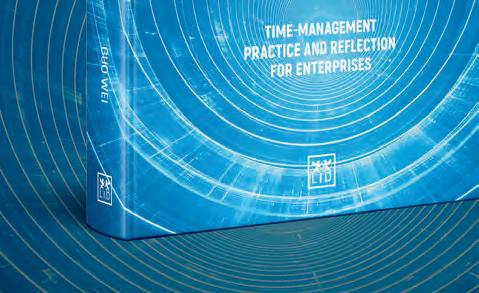

“The book provides a classic methodology that extends from personal time management to leveraging time management as a tool for corporate strategic management…In the opening passage of the book, Guo writes that ‘Resources are limited, while human desires and needs are infinite.’ It is a fact too easily forgotten. The role of business leaders is to find ways to meet demand with a finite supply of this most precious resource. The Power of Time is a great place to start.”

PATRICK WOODMAN Editor of Dialogue leadership magazine

“Time is the scarcest resource for everyone. Guo Wei is an expert in time management, and his book can inspire courage and strength on the battlefield of time, helping you achieve more. It is also an excellent and practical guide for both personal and corporate time management, especially for entrepreneurs… The Power of Time not only helps individuals achieve excellence in the race against time but also provides significant opportunities for business growth.”
MICHAEL YU Founder
and Chairman, New Oriental Education & Technology
Group


The science is strong. Our imagination is weak
In Silicon Valley, where I live, the world’s most brilliant minds and wealthiest investors chase the shallowest dreams. The valley that once gave us the personal computer and the internet has become a carnival of hype. AI startups promise to “revolutionize” everything. Yet they mostly generate synthetic influencers, fake news and shallow automation.
Venture capitalists pour billions into algorithms that mimic intelligence but rarely advance it. We have turned the greatest technology engine in history into a factory for distraction. This is not because technology has failed us – it is because imagination has. When America put a man on the Moon in 1969, its onboard computer had less power than the greeting cards that sing Happy Birthday What took us to the stars was courage and purpose. Those have gone missing –somewhere between the venture-capital term sheet and the app store.
Human progress once crawled forward: millennia from pottery to plough, centuries to calculus, decades to electricity. It now accelerates faster than our minds can grasp. Over the last 100 years, technology has advanced beyond anything our forebears could imagine. That’s nothing new: humans failed to understand exponentials then, just as they struggle to understand them now. People are hardwired to the familiar: they cannot grasp how fast everything is advancing. Thus, we remain prisoners of habit, chasing short-term returns while ignoring the exponential tools in our hands.
Even India, my native country, is falling into that trap. Its great cities choke on toxic air and drink poisoned water while entrepreneurs build yet another delivery app. Every time I visit, I get sick from drinking the water, because of the polluted
We have turned the greatest technology engine in history into a factory for distraction
waterways, and the mass-scale industrial dumping in the rivers.
Water testing is needlessly slow and cumbersome, but the science exists to make it instant. That’s why my company wants to use its technology to examine the nation’s water supplies. The Yamuna, the Ganga, then across India. The cost of using that technology for 30 seconds is almost nothing. In just one minute we can identify the composition of the liquid, be it drinking water, urine or blood.
The technology to fix so many societal problems already exists. They could cover Delhi and Mumbai with smart sensors that monitor every drop of water and every breath of air, in real time and at minimal cost. But most entrepreneurs lack the will to apply their brains to what truly matters. The silver bullet is there, but inventors misfire. They set their sights on solutions we have already solved.
Still, there is hope. Unlike Silicon Valley, India’s innovation story is young – and its moral compass still intact. I have seen young scientists and engineers who want to cure disease, clean water, and rebuild trust in technology. They believe that science must serve humanity, not manipulate it. Rooted in ethics and purpose, they can fuse ancient wisdom with modern science, and lead the world in the responsible use of AI and deep tech.
We have crossed the line where technology is the limit. The only barrier left is our ambition –and our imagination.
Vivek Wadhwa is author of The Immigrant Exodus: Why America Is Losing the Global Race to Capture Entrepreneurial Talent

conduct, anchored in higher-level standards covering governance, strategy, business models, and material impacts, risks, and opportunities. Though some view these requirements as onerous, they are creating incentives for innovation-led growth – with opportunities to improve circularity, scale technologies, and deepen stakeholder engagement.
US progress on clean tech is losing momentum as the EU surges forward with an evolving policy playbook
Writing Chris Vas
Europe is writing the playbook for clean industrial growth, while America risks squandering its clean-tech moment. Policy whiplash and reversals in the US are dulling business prospects and eroding consumer confidence – especially in the eyes of international markets. The EU, by contrast, is surging ahead on the back of a playbook for clean growth that is helping to mobilize investment, unlock innovation and drive changes in corporate activity.
The question now is whether US companies can out-innovate the emerging policy gap and respond to changes in the commercial environment, at a time when EU frameworks have made technology diplomacy, value-chain engagement and ecosystem leadership increasingly critical dimensions of business leadership.
The Clean Industrial Deal (CID) – the EU’s flagship effor t to accelerate clean-technology investment – is set to mobilize over €100 billion to boost domestic growth, cut energy costs and rebalance value chains. A response to geopolitical turbulence and shifting industrial policies, it aims to move Europe beyond playing catch-up with the US, where clean-tech investment rose from $111 billion in 2020 to $271 billion in 2024.
In parallel, large EU companies have begun reporting under the Corporate Sustainability Reporting Directive (CSRD), which has a scope that extends beyond climate impacts to value-chain analysis, stakeholder engagement, and business
New EU policies demand sustained investment in clean technologies
The leadership mandate is clear: widen the lens, raise standards and prepare for greater responsibilities. As leading companies demonstrate, a new approach is taking shape.
Tackling circularity Denmark’s Ørsted is Europe’s largest wind-power company (and the developer behind the $1.5 billion Revolution Wind project off Rhode Island, which recently received a controversial stop-work order from the US government). Ørsted’s CSRD reporting now accounts for upstream and downstream activities, with raw-material use and waste management treated as strategic considerations. Reducing virgin inputs, extending resource life, and recirculating end-of-life materials have become integral to core operations.
France’s Airbus shows similar momentum. In its CSRD-focused reporting, nearly three-quarters of its waste is attributed to industrial operations – metallic, chemical and packaging streams. Its heavy reliance on titanium, a critical raw material, now receives board-level attention. In the past, such matters were left to operational teams; today, reporting requirements mean they sit firmly on the agendas of senior leaders and boards.
Scaling technologies The push to invest in advanced clean technologies is also intensifying. Ørsted has introduced heavy-lift cargo drones to reduce greenhouse gas emissions from offshore operations, slashing delivery times to turbine nacelles to just four minutes, compared to as much as six hours using shipping vessels – improving productivity by a factor of 10 to 15 while also reducing emissions. Such efficiency gains, extending from operations to carbon performance, deliver a clear competitive edge.
Airbus is also scaling its investment in innovation. The company has committed €6 billion to research and technology, aiming both to realize efficiencies in existing systems and to develop emerging technologies, such as sustainable aviation fuels, hydrogen power, and new energy storage and distribution solutions. Airbus regards continuous technological advancement as critical to its long-term growth.
Stakeholder engagement CSRD has also sharpened the focus on stakeholder engagement. Ørsted’s reporting clearly identifies the importance
of political support and constructive dialogue with authorities, suppliers, investors and joint-venture partners. For Airbus, stakeholder engagement spans 355 operational sites and more than 30,000 supplier locations; the transparency and performance of supply-chain partners now feed directly into enterprise risk assessments. Supplier practices are no longer peripheral: they shape risk, resilience, and brand reputation at the enterprise level, and they must be reported.
Developments at Ørsted and Airbus are not occurring in isolation. Companies across sectors are reshaping their practices to adapt to the EU’s evolving policy environment. While the EU excels at crafting innovative policy and legislative
frameworks, execution remains a challenge; however, it is leveraging geopolitical shifts to accelerate implementation.
The trajectory is clear: the race to a cleaner industrial future is already underway. For boards and executives, three lessons stand out.
Technology diplomacy Leaders must invest in technology diplomacy. Amid heightened geopolitical competition, private sector leaders should inform policy thinking and champion open diplomatic channels for technological advancement. Effective cross-border technology transfer is now essential. The €4.1 billion collaboration between China’s CATL and Spain’s Stellantis on lithium battery technology demonstrates the scale of commitment required. Building local capacity is vital, but so is deepening competitive advantage in emerging areas, such as battery recycling.
Value-chain engagement Leaders must look beyond internal operations. As EUbased companies are assessed on upstream and downstream impacts, their suppliers – whether within the EU, or in the US, Asia, or elsewhere –face the same pressure. Companies that fail to adapt will be excluded from value chains that demand accountability. For the EU, outward engagement is a consistent strategy. Even when facing protectionist regimes, European companies will continue to rely on global partnerships, with a modus operandi focused on scale: those partnerships will, however, be subject to stronger standards.
3
Ecosystem leadership Leaders must think at the level of ecosystems, not just enterprises. Policy innovations, such as the CID, will push companies to demonstrate collaboration beyond traditional organizational boundaries. The Airbus Hydrogen Network includes over 215 airports alongside energy providers and airline partners. This is the future of leadership, where commercial viability is harmoniously paired with environmental alignment; success is driven through collective ecosystems rather than isolated companies.
Dr Chris Vas is an innovation and technology policy expert and adjunct associate professor at the University
of Canterbury, New Zealand
The implications are clear. New EU policies bring sharper reporting standards, greater responsibilities for leadership, and heightened accountability for boards. They also demand sustained investment in clean technologies and value chain resilience. Resilience remains important, but it is no longer enough. Leadership in this environment requires boldness and courage: investing in technology diplomacy, rethinking value chain responsibilities, and building ecosystems that can succeed in a low-carbon world.



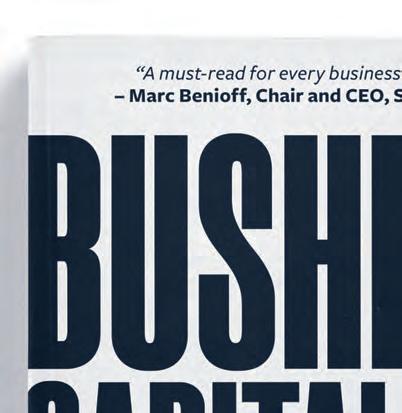
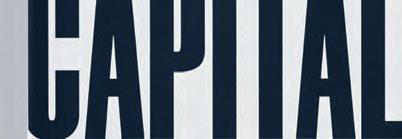

“Sakurada reminds

–
Co-founder




ALEXANDER C. KARP
and
CEO
of Palantir Technologies Inc.



“Drawing
– DANIEL PINK
New York Times bestselling author of When, Drive

The chief financial officer’s brief used to be simple: the focus was on accounting accuracy, regulatory compliance and financial stewardship. Like Dorothy taking her first steps along the Yellow Brick Road in the 1939 movie classic, The Wizard of Oz, early CFOs were concerned with staying on the path, ensuring no misstep jeopardized the company’s survival.
As technology matured, so too did the role of the CFO, shifting from recordkeeper to strategic adviser – and today, the emergence of AI-driven financial intelligence is again reframing the journey. Organizations can now imagine an AI-CFO – a digital architect, guiding every decision with precision, speed and predictive power. The characters of that old story shed light on what lies ahead.
Start with the Scarecrow, who longs for wisdom. Early CFOs grappled with raw financial data, lacking the tools to produce deep insights. They were measured by how meticulously they accounted for what had happened. Then, enterprise resource planning (ERP) systems, data visualization tools and market analytics emerged. CFOs evolved into sophisticated thinkers, blending finance with business strategy. Like the Scarecrow, they realized they had always possessed intelligence – they just needed the right tools to express it.
AI-CFOs transcend this. Equipped with machine learning and predictive analytics, they don’t analyze the past, but forecast scenarios accurately via trillions of calculations per second. The AI-CFO simulates thousands of ‘what if’ paths, constructing a roadmap clearer than any yellow brick track.
Think next of the Tin Man. His search for a heart represents CFOs’ journey from efficiency to empathy, the focus on operational efficiency tempered by emotion. Traditional CFOs wielded the financial axe remorselessly, trimming inefficiencies to oil the corporate machine. They were the heartless Tin Man – hard, metallic, transactional.
Yet, over time, CFOs discovered the importance of empathy, becoming leaders who aligned financial rigor with human capital needs, sustainability and trust. CFOs infused heart into their numbers, opening their eyes to how financial
Organizations can now imagine an AI-CFO – a digital architect, guiding every decision
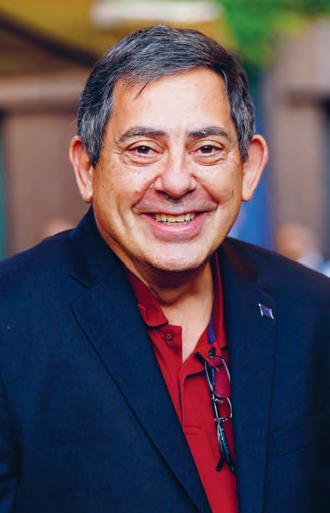
decisions impact employees, communities and ecosystems.
The AI-CFO reverses this. It is pure mechanism, no emotion. It cannot – at present – understand the subtleties of morale, trust or ethical compromise. The future may belong to a hybrid, whose computational precision is complemented by empathy and judgment.
Next, the Cowardly Lion, who embodies a search for courage. Early CFOs often hesitated at risk-taking, their responsibility resting in protecting the balance sheet. By the late 1990s, CFOs had grown into lions with plentiful courage. They led in mergers, acquisitions and digital transformations – not as guardians, but entrepreneurs.
Enter the AI-CFO, who has no concept of fear and can dispassionately evaluate risks, model potential losses, and suggest optimal strategies without hesitation. But courage only means something in the presence of fear. The AI-CFO may guide, but the lion’s roar will always come from humans who choose to act.
Behind the curtain, of course, we find the Wizard – a figure of authority cloaked in mystery, projecting strength while hiding fallibility. CFOs were once wizards of numbers – consulted with awe, operating in ways few could comprehend. Their forecasts seemed near-magical, their decisions beyond questioning. But eventually, businesses realized the unmasked CFO was not omnipotent. Transparency, accountability and collaboration replaced mystery.
The AI-CFO resurfaces this illusion in a new form. Algorithms and black-box systems appear inscrutable. Financial leadership stands behind a digital curtain.
Here lies an enduring lesson: true leadership is not the mere projection of power, but clarity, accountability and integrity, whether human or machine. The future is partnership: walking together –human and AI – towards a world where finance not only counts numbers, but truly counts for something.
The problem is global. Billions of people lack the knowledge or tools to make informed financial decisions. ‘Thin-file’ customers – those about whom there is little financial data, including students, recent immigrants, gig workers and sole traders –number about 2 billion worldwide.
There are also problems around small businesses, the engines of jobs and economic growth. Sixty-five million of the world’s 360 million formal SMEs face an access-to-finance gap, driving an annual shortfall of $5.2 trillion (or $8 trillion when informal enterprises are counted). This isn’t about uncreditworthy customers; it’s about outdated models that can’t see their potential.
That realization collided with another. Inside large, listed institutions, short-term numbers can eclipse long-term value. Innovation stalls, customers go underserved, trust erodes. I wasn’t frustrated with any one person or company; I was frustrated with a system that too often fails the people it’s meant to serve.
So from that small Amsterdam office, we built tools to address those systemic failings. We started with eyeOpen, one of the first robo-mortgage advisers; then we launched AdviceRobo, using psychometrics and behavioral signals to rethink risk and inclusion.
Here’s how human-centered AI will transform financial services
Writing Diederick van Thiel
When I left the boardroom of ING, one of Europe’s most powerful banks, for a small, half-empty office in a forgotten corner of Amsterdam, I had nothing but two leather chairs, a vision and a handful of algorithms. Many thought I had lost my mind.
In truth, I had found my purpose. When I led the daily banking domain at ING and shaped strategies for the next generation, I kept running into an uncomfortable truth: we’re graduating brilliant young people into a financial system they are not prepared to navigate. Not because they lack talent or ambition, but because we don’t teach them the necessary skills – and because access and advice remain out of reach for far too many.
Banking
5.0
is not just about efficiency. It is about empathy at scale, delivered through new business models
The lesson that changed everything was this: beneath every data point is a person. When finance learns to see the person, everything else follows. Data alone doesn’t make lives better –understanding does.
This conviction is what I call Banking 5.0, a strategic shift from legacy, product-centric models to a human-centered system, where AI plus behavioral economics delivers services that are both smarter and more empathetic.
The emergence of Banking 5.0 Banking has always evolved with technology. Paperbased ledgers gave way to mainframes and ATMs (Banking 2.0). The internet ushered in online banking (3.0). Smartphones enabled mobile-first, platform ecosystems (4.0). But each stage, while technologically impressive, remained shaped by a legacy mindset: products first, customers second.
As I explore in Brilliant Data, Banking 5.0 is different. It represents the fusion of AI’s predictive power with human-centered design. It asks not only “What can we automate?” but “What outcomes do people need?” It demands new financial business models that merge AI with behavioral economics. AI identifies patterns and predicts outcomes with precision; behavioral economics explains why people decide the way they do, shaped by biases, heuristics and emotion. Where one discipline provides foresight, the other provides context. Together, they allow
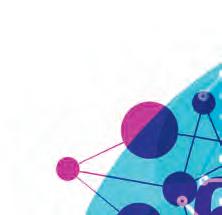
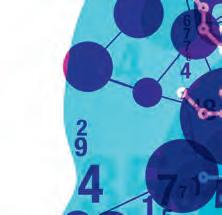









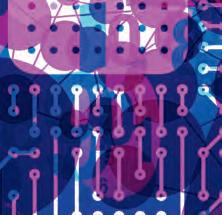


finance to move from reactive to predictive, from generic to personalized, and from transactional to preventative – at scale.
When combined, these disciplines give us a powerful toolkit for designing financial services that anticipate needs, align with human behavior, and foster trust.
This duality – machines plus meaning – is what sets Banking 5.0 apart. It is not just about efficiency. It is about empathy at scale, delivered through new business models that scale like super apps, digital assistants or digital guardian angels.
Applications for brilliant data Financial institutions sit on oceans of behavioral









data: payment rhythms, app taps and swipes, pauses and hesitations. Yet for years, much of this was treated as a compliance artifact rather than a source of value.
In our fintech work (and my PhD research), we found that behavioral intelligence consistently outperformed legacy proxies. When we complemented traditional variables with psychometrics and behavioral signals, real differences emerged (see box, p62). They indicate the potential value that can be realized by utilizing the brilliant data that has been so far neglected. Banking 5.0 is not a theoretical future. It is already reshaping financial services across multiple dimensions.
Traditional scorecards exclude the very people building the future: students, gig workers, immigrants, sole traders, and many women-led and first-time businesses. Thin-file segments total about 2 billion people. If behavioral models help us responsibly approve 30% more of them, that’s about 600 million new participants, and an estimated $2.5 trillion reduction in the access gap –without raising risk tolerance.
Risk management: from early signals to early action AI can scan millions of transactions in real time. Add behavioral cues – timing shifts, stress indicators – and banks can spot vulnerabilities before arrears, enabling proactive restructuring, hardship support or fraud interventions. This is prudence with empathy. This enables proactive outreach, protecting both customers and institutions.
Customer engagement: nudges that build resilient habits Instead of generic product pushes, use behavioral design to deliver goal-aligned nudges: save when income spikes, calm over-spend surges, pre-commit to bill smoothing, microinvest windfalls. Adoption rises when advice feels personal, timely and non-judgmental.
Inclusion as a growth strategy Next-gen customers move to apps. Migrant workers trust lower-cost remittances when transparency is high and flows are explainable. Low-income customers build buffers with round-up savings. SMEs access dynamic, cash flow-based credit that flexes with seasonality. Inclusion ceases to be charity; it becomes profitable growth expansion.
Retention: loyalty through empathy Customers remain loyal to institutions that understand them. AI-driven personalization – financial health scores, dynamic limit-setting, proactive alerts, relevant offers – shows empathy. Trust, once lost, is hard to rebuild. Banking 5.0 helps build lifetime value from the start.
These are not hypothetical possibilities. They are the lessons of lived innovation – successes, failures, and the surprising discoveries that shaped both my companies.
Challenges and ethical considerations
Powerful tools demand responsible use, and Banking 5.0 raises ethical questions that leaders cannot ignore. Behavioral insights can easily cross the line from helpful nudges to manipulation –pushing higher-margin products that serve the institution more than the customer. The boundary
between guidance and exploitation is thin, which is why safeguards matter: radical transparency about intent and impact, independent oversight, and a genuine customer-first ethos.
Trust also hinges on data stewardship. Financial data is among the most sensitive information people possess, so institutions must act as custodians, not extractors. Compliance with data privacy regulations like Europe’s GDPR or California’s Consumer Privacy and Privacy Rights Acts (CCPA and CPRA) is only the baseline. True differentiation comes from clear, comprehensible practices, and demonstrable customer benefit.
Finally, human oversight remains essential. AI models are powerful but imperfect; they can misread behavior or reproduce bias. Decisions that affect lives – loan approvals, fraud alerts, investment advice – must include human judgment. AI should augment, never replace, human responsibility. Handled with care, these challenges become opportunities for leadership; mishandled, they erode the very trust on which banking depends.
Strategy first: the asymmetric advantages of Banking 5.0
The next question is strategic: why does Banking
When traditional variables were combined with psychometrics and behavioral signals, substantial di erences appeared.
Lenders saw substantially higher acquisitions –approving more good customers 23%
They saw lower defaults – be er risk separation
The lesson
At system scale, applying a 23% reduction to a delinquency pool of about $2 trillion (on $59 trillion in global household and SME debt) implies $460 billion in avoided losses
$3 trillion
Combined with expanded approval for viable thinle segments, the total opportunity approximates $3 trillion
AI can read behavior – behavioral economics can explain it. Together, they turn raw signals into predictive, personalized, preventative nance.
Consider this: two customers may earn the same salary and spend in similar categories, but one may be risk-averse, while the other is impulsive. Traditional data treats them identically. Behavioral data tells us they will respond very di erently to nancial stress or opportunity.
5.0 win, and
5.0 win, commercially and ethically, without asking leaders to take more risk? The answer lies in four asymmetric advantages that compound over time. They come from seeing behavior more clearly – not from loosening standards.
1 New addressable market, same risk appetite










data behavioral managers, risk and need to work
scientists, behavioral economists, designers, product managers, risk and compliance need to work side by side, so that academic depth meets commercial pragmatism.

Behavioral models surface good risk that legacy ratios miss – thin-file customers, firsttime entrepreneurs, seasonal SMEs. You expand profitable inclusion without relaxing thresholds, adding growth discrimination rather than greater




quarter but the next


As a father of four, I’m acutely aware that we are not financial systems for alone.





time entrepreneurs, seasonal SMEs. You inclusion without thresholds, by better discrimination rather than greater exposure.




2 Bending the opex curve Human-centered AI democratizes banking guidance. shifts from human-only to human economics improve: always-on coaching, consistent quality, and lower cost to serve – especially in segments incumbents struggle to reach. That has a direct impact on operating expenditures (opex).
3


AI democratizes As advice shifts from to human plus AI, unit economics consistent




Compounding trust Visible fairness, clear explanations and proactive support translate into loyalty, referrals and higher lifetime value. In a commodity market, trust becomes the moat that spreadsheets can’t copy – and it gets stronger with every transparent decision.
4 Speed with integrity Behavioral models can run as additive or threshold scorecards alongside existing systems, so you can move fast without betting the bank. You learn in parallel, keep humans in the loop, and scale what works – safely.
Together, these four advantages turn inclusion into a growth engine and prudence into a differentiator – setting up the leadership moves that follow.
Leadership imperatives for transformation
Banking 5.0 is as much about leadership as it is about technology. My own path from corporate executive to entrepreneur taught me that strategic courage, an innovative culture, and ethical responsibility are the real levers of change. This means shifting our gaze from products to outcomes: boards and executives must measure success not by the number of loans booked but by the number of lives improved. It also means moving from silos to squads. These capabilities cannot live at the periphery:
Dr
Diederick van Thiel is cofounder of AdviceRobo and a researcher in humancentered AI. He is the author of Brilliant Data (LID Publishing)
Leadership in this era also requires a longer horizon. For me, it is not about the next quarter but the next generation. father of four, I’m acutely aware that we are not building financial systems for today alone. We are building for a world shaped climate change, inequality, and digital transformation, and that demands designs that serve not only shareholders but society.










We are building for a world by climate inequality, and rapid digital transformation, and that demands that serve not shareholders but These are not abstract. are the lessons I wished I could have applied more fully inside large institutions – and the ones I have tested, sometimes as an entrepreneur. Taken describe the essence of


These imperatives are not abstract. They are the lessons wished I could have applied more inside institutions – and the ones I have sometimes painfully, as an entrepreneur. Taken together, they describe the essence of leadership in the Banking 5.0 era.
Toward a more inclusive financial future
Banking 5.0 is not only about faster transactions or lower costs. It is about reimagining finance as a driver of value, trust, and inclusion by blending AI’s predictive intelligence with behavioral economics’ human insight. Done well, it delivers truly personalized services tailored to each person’s context, provides preventative support that addresses risks before they escalate, and builds inclusive systems that bring underserved communities into the financial mainstream. This is finance not as a gatekeeper, but as an enabler; not as a product machine, but as a human partner.
For customers, it means advice that’s accessible, timely, and humane; private-banking-grade coaching without the private-banking price tag. For SMEs, character and cash flow matter again; viable businesses aren’t turned away by a ratio logic rooted in the 1920s. For embedded finance players, it means opening a profitable new frontier, while cutting avoidable losses. And for society, it means that financial capability increases, defaults fall, entrepreneurship rises, and trust returns. Critically, banking 5.0 isn’t about loosening standards. It’s about seeing people more clearly.
Finance can indeed be more human, more inclusive and more just. But it requires leaders with the courage to innovate beyond products, to think beyond quarters, and to design for the next generation. Finance should be the engine that powers possibility. The numbers say the market is ready; the technology says the tools are ready. The only open question is leadership. Start now.







“We know that brands change behaviour. We know that if the world is to have any kind of a sustainable future, behaviour must change. This book shows how sustainable, regenerative brands can be that future. So this might be about the most important book this decade about human behaviour and how to change the world.”
We know that brands behaviour. to any kind of a sustainable future, our behaviour must This book shows how sustainable, brands can be that future. So this be about the most important book this
JONATHAN CHENEVIX-TRENCH
Former Chairman, Morgan Co-owner, Madresfield Court and Mad About Land


Former Chairman, Morgan Stanley, Co-owner, Madresfield Court and Co-founder, Mad About Land







SIMON MOTTRAM

“Brands and branding are concepts that everyone seems to know about today, but the difference between brands as veneer and brands we can believe in has never been more stark important. Bob’s book gives valuable guidance on how to build brands that will succeed and last.”
“Brands and branding are that everyone seems to know about but the difference between brands as veneer brands we can never more or more Bob’s book valuable on how to build brands that



Founder, Rapha Performance Roadwear
Founder, Performance Roadwear







“Sheard is a marketing savant who channels his the mutually beneficial relationship brands must embrace to ensure their His for this union is a call to action for to our
“Sheard is a marketing savant who channels his expertise by exploring the mutually beneficial relationship brands must embrace to ensure their legacies. His passion for this union is a call action for global unity to protect one shared gift.”
PHYLICIA FANT
Global Head of Music, Amazon
Global Head of Amazon






Marketers are not doing enough to address growing consumer skepticism
The front of a can of Dalston’s rhubarb soda proclaims, “Real pressed rhubarb & sparkling water.” Yet this soft drink is just 4% rhubarb; there is more apple juice than rhubarb in every can. Such statements are so common as to seem entirely normal – but I wonder if we have crossed a line in consumers’ willingness to swallow such claims.
Marketing agencies may be to blame, as one contributor to a recent Reddit discussion in r/DigitalMarketing suggested. “Lately I’ve been seeing more marketers making completely unrealistic claims when pitching to companies,” they wrote. “Stuff like ‘we’ll 3x your revenue with our ad strategy’ or ‘our emails will completely transform your business in 30 days.’” These are, the contributor noted, wild promises that collapse under scrutiny – and they are corrosive of trust.
The Marketing Society calls trust “marketing’s most valuable and vulnerable currency,” but points out that we live in “the skepticism era.” It can take years to build trust, but just minutes to destroy it – and it seems to me that marketing leaders aren’t doing enough to preserve this precious asset.
That’s surprising, because trust is central to an idea that the industry is increasingly reliant on: authenticity. A recent survey by Stackla in the US, UK and Australia found that 90% of consumers said authenticity is important to them when deciding which brands they support.
As ever, numerous definitions are available, but I think of authenticity as honest, transparent content created to communicate a brand’s true values and actions. It’s based on noble sentiments – and when done right, it should build both trust and brand preference. But for consumers living in the skepticism era, who may be scrutinizing every promise and questioning every claim, there is an inherent weakness in my definition. It focuses on content creation and communication – but of course, actions speak louder than words.
Trust is central to an idea that the industry is increasingly reliant on: authenticity
It may be time, therefore, to underpromise and overdeliver. Spending a little less on communication budgets and more on product and performance would be a step in the right direction. However, there is a challenge here. Many companies have become slaves to performance marketing – the latest incarnation of the longrunning tension between finance and marketing directors, with their contrasting focuses on short-term (quarterly) results and long-term relationships. It is the difference between sales now, versus lifetime value. In many companies, the balance of power has shifted toward the CFO and performance marketing – which doesn’t bode well for authenticity.
The final problem with authenticity is a collective one. The era of skepticism isn’t going to be ended by one brand alone: it will need thousands of individual brands to change. And it will need inauthentic brands to be called out –even punished.
This may seem contrary to the ideals of free trade, but what’s needed is tougher regulation. Inauthentic brands need to feel like the exception to the rule, not the industry norm. Of course, this is a difficult ask: getting brands to sign up to greater regulation, to abide by it, and to call others out and police it, is far from simple.
In the meantime, change begins at home. Ensuring your brand doesn’t just speak but acts authentically is an important step in the battle to rebuild trust in marketing and advertising – but only a first step on what will be a long, hard road.
Giles Lury is
an independent brand consultant and writer

theater – the issue becomes clearer. Every job, like a part in a play, has three components: the role itself, the individual in that role, and the surrounding environment. A mismatch can doom even the most talented actor. In the C-suite, that mismatched role is often the CMO.
To map this complexity, we developed the first conceptual model for CMO Role Design, identifying three interconnected layers.
Building alignment between the person, the job requirements, and the organizational context is essential for marketing chiefs to thrive
Writing Kimberly Whitler
When a senior executive underperforms, the typical responses are predictable: place them on a development plan, rotate their role or dismiss them. But what if the struggling leader is the chief marketing officer (CMO) – the individual responsible for driving revenue growth? Too often, the problem isn’t the person but the role itself.
A new study in the Journal of the Academy of Marketing Science, co-authored by Lopo Rego (Kelley School of Business), Neil Morgan (Wisconsin School of Business), and me, reveals that 54% of CMO roles are poorly designed. Expectations often clash with responsibilities and success metrics, making it difficult for companies to design the CMO role effectively. It’s therefore not surprising that CMOs have the highest turnover rate in the C-suite: nearly a third of the companies in our data set had three or more CMOs within 10 years. Such chronic turnover suggests that many companies don’t have a CMO problem: they have a CMO role-design problem.
At the heart of our research is a deceptively simple question: What exactly is a CMO supposed to do? If we examine the role through the lens of role theory – a sociological framework borrowed from
The lesson is clear: success comes from the alignment of person, role and content, for film stars as for CMOs
1 CMO role characteristics This layer includes person-based characteristics – such as the candidate’s competencies, background, experience and education – and position-based characteristics that define the structural boundaries of the job: what the CMO is expected to do, what resources they are given, how much authority they have, and what they are accountable for.
2 Contextual factors This layer includes both internal factors (such as company strategy, structure and culture) and external factors (such as market dynamics and regulatory constraints), as well as considerations such as whether the CMO is part of the executive team, whether they attend board meetings, and CMO turnover.
3 Consequences The consequences include brand equity, customer relationships and overall firm performance.
Consider a cinematic analogy. Sean Connery became the archetypal James Bond because his style and experience matched the role. However, even an actor as great as Connery wasn’t suited for every film part. His performance in the poorly reviewed 2012 animated comedy Sir Billi shows that success depends as much on fit as on talent. Context is also vital: some Bond films succeed due to strong villains, clever plots or charismatic performances that are lacking in other titles.
The lesson is clear: success comes from the alignment of person, role and context, for film stars as for CMOs. The attributes of the position and the person must align – yet too often they don’t, like a square peg and a round hole.
One important contextual factor is the CMO’s status within the executive suite. Status matters because CMOs rarely act alone – success depends on collaboration with finance, product and operations departments. Higher status helps them influence decisions and coordinate across teams; lower status risks marginalization.
However, more status is not always better. When the role is well designed and aligned, added status amplifies impact. When it isn’t, higher status

can backfire, worsening the mismatch between responsibility and experience.
Getting CMO role design right What can chief executives, executive recruiters and candidates do to prevent these missteps? We have developed a practical set of tools to improved role alignment (see ‘Set Up to Fail’, MIT Sloan Management Review, summer 2022).
Note that the problems of role design are not exclusive to CMOs. When we examined 185 job specifications for CFO, CIO and CMO roles, we found widespread misalignment between expectations, authority and skills. In 41% of cases, requirements did not match candidate qualifications – and in over a third, responsibilities conflicted with the experience sought.
To address this disconnect we created the Job Alignment Map, a tool for crafting more effective job specifications and evaluating whether an existing role is well designed. It concentrates on six elements.
1 Expectations – the organizational outcomes the role should deliver
2 Required responsibilities – the authority needed to meet those expectations
3 Assigned responsibilities – whether they match those required to meet expectations
4 Required skills – the skills, experience and training needed to succeed in the role
5 Skills listed – whether the job specification reflects those requirements
6 Performance measures – the indicators used to assess progress towards expectations.
The Job Alignment Map can help leaders –and candidates – determine if a role is set up for success or destined to fail. For example, if a CMO is asked to “drive the growth agenda” but lacks authority over strategy, product, pricing or sales, it’s a warning sign. Recruiters can use it to match responsibilities with expectations, while CMOs can clarify performance metrics or negotiate scope before accepting a role.
Any aspiring CMO should avoid relying solely on the job spec – it’s often sales material. Instead, ask the CEO about responsibilities, success measures, structure, budget and team to ensure the role is properly set up for your success in the organization.
The research is clear: misaligned CMO roles can derail marketing effectiveness – and careers. Organizations and marketing leaders alike are well advised to focus on CMO role design.
called it the Blink Factor, recognizing the rising importance of emotional instant connection in how consumers experience brands.
Writing Jean-Pierre Lacroix
The marketplace is witnessing the rapid adoption of new technologies such as AI, fueling a pace of transformation across organizations not seen since the advent of the computer. The acceleration of change is driving commoditization, forcing organizations to rethink how to sustain long-term competitive advantage, innovation and marketing. For brands, AI is also ushering in new sentiment analysis technologies, providing the ability to dig deeper into the emotional factors that drive purchasing decisions, shifting the narrative away from features and benefits, and putting a renewed emphasis on the need to create emotional shortcuts – on how brands make customers feel.
This acceleration demands that companies move beyond simply talking about values. To build instant, lasting connections, leaders need to embrace the science of visual design.
Customers form their first impression of a brand in just 300 milliseconds, faster than the blink of an eye. While corporate values and mission statements remain valuable tools for leadership teams in shaping brand identity, growing evidence shows that visual design plays an even greater role in building meaningful customer relationships. We first identified this phenomenon in the 1990s and
Customers form their first impression of a brand in just 300 milliseconds, faster than the blink of an eye
Now, thanks to advances in brain science, we know more than ever about the snap judgments made by the human mind. Our brains process visual information at an extraordinary speed –about 60,000 times faster than a computer. While it takes several seconds to read a value proposition, a brand’s visual identity makes its impact instantly.
These aren’t just academic findings; they reflect the reality of the marketplace. Consumers are confronted by overwhelming choice, with up to 47,000 products in the average supermarket, meaning they increasingly rely on visual shortcuts. Snap purchase decisions happen up to 3,000 times faster than rational ones – yet many companies still try to compete primarily on functionality and logic.
Emotional elicitation and the role of design
Rather than trying to win on logic, brands should focus on eliciting an emotional response to create a connection. A recent SLD/Customer Obsession study analyzing 2,000 customer reviews across 18 major chains revealed that emotional involvement is the consistent driver of loyalty, beyond price or convenience. Brands like Chick-fil-A and Texas Roadhouse aren’t the cheapest options, yet they stand out by delivering experiences that feel right from the start.
That makes design critical. Forty years ago, design was not seen as a fundamental business function; it was often treated as an afterthought or an appendage to strategy, rather than a driver of it. Today, the most successful organizations have flipped that mindset: design has become integral to planning and a core source of competitive advantage. The emergence of desktop computing accelerated design cycles, placing design leaders at executive tables and embedding design thinking into top-level decision-making.
The shift has been profound. Where classical branding focuses on articulating values and beliefs, appealing to conscious thought, design-driven branding is rooted in what customers experience, engaging the brain’s immediate, emotional processing. Apple exemplifies this transformation. While the brand champions innovation, what truly sets it apart is design: sparse layouts, intuitive interfaces and iconic packaging. Every design choice – what we call the code language of brands – acts as an image metaphor, triggering an emotional response long before a customer ever reads a feature list. Simplicity and elegance are not just Apple’s promise; they are present in every touchpoint of the brand.
Lego is another excellent example of the power of design as a transformational tool. The
organization was on the verge of irrelevance due to declining sales and a lack of broad appeal until it adopted a design thinking approach. Transforming the brand through licensing agreements and refocusing on the power of creativity for both children and adults helped revitalize Lego as an iconic brand.
Images that instantly convey complex ideas, such as visual metaphors, remain underutilized in branding. Unlike verbal messages, they bypass rational thought and deliver direct emotional data, effortlessly crossing language, cultural, and educational barriers.
The strategic application of visual metaphors marks the beginning of a new era in brand identity. Research shows that color alone drives up to 80% of brand recognition, while shapes and other graphic elements can profoundly influence perception and emotion. Together, these cues create what researchers call “customer love marks” – deep emotional bonds with brands that rational messaging alone can never achieve.

While many brands still rely heavily on functional differentiation, market leaders recognize that emotional attachment is the real driver of loyalty and long-term profitability. Emotion influences up to 80% of purchase decisions, and emotional appeals are 24 times more persuasive than rational ones. An authentic visual shortcut can serve as one of the most powerful strategic assets a brand can own. Research consistently confirms that emotionally-connected consumers are more loyal, spend more, and advocate more. In banking, for example, emotionally engaged customers deliver 52% greater lifetime value than those who are merely functionally satisfied.
Capturing this competitive advantage requires a redefinition of brand strategy: shifting from internal strengths to customer emotions, from product attributes to image-driven narratives, and from rational explanations to compelling emotional appeals.
To enhance how your brand connects with audiences, follow these three tips.
Audit the brand for emotion Assess current branding on an emotional level, rather than focusing on message clarity. Explore factors the brand can own, beyond functional benefits. How does it makes customers feel?
Treat design as strategic Color, spacing, typography, and all other design choices must






Jean-Pierre Lacroix is president of Shikatani Lacroix
Design and author of ThinkBlink Manifesto: Creating Deep, Lasting Emotional Brand Connections in the Blink of an Eye (FriesenPress)
be understood as strategic investments in customer relationships, rather than being issues of ‘style.’ Brands that use design as a cosmetic tool undermine their ability to create consistent memory purchase shortcuts.
Measure emotional impact Measures such as Net Promoter Score or customer satisfaction only provide partial information about brand health. Customer relationships need to be monitored via sentiment analysis and emotional engagement scores to provide a full understanding of how design decisions affect relationships.
As AI evens out the playing field in terms of functional capabilities, the most sustainable competitive advantage is now emotional differentiation. Those companies that learn to create emotional relationships in the blink-of-an-eye will win loyal customers and dominate their markets.

Better is the yardstick for management with agile, people-centric and dynamic features. As such, it turns management into a competitive advantage – one of the few advantages left in a time where they dissolve faster than ever before. Better Management gets work done, creates value; it is unique and hard to copy, it prevents short cuts and is deeply rooted in culture. That’s why it deserves the attention of every manager.
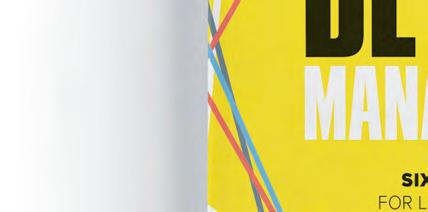


“Better management is badly We learn about it daily from media. Failures in management often attributed to managers. Michel makes the case that and practice need an upgrade offers six principles for the


“Better management is needed. We learn about it from the media. Failures in management are often attributed to managers. Lukas Michel makes the case that theory and need an upgrade and offers six for the fix.”






MICHAEL KÜHNER CEO, Strametz & Associates

MICHAEL , Strametz & Associates



“Lukas Michel’s new book leader and tools and serves as a will help organization from activity-based organizational
new Better Management provides every leader with compelling insights and tools and serves as a time-tested and validated blueprint that will help to shift an from leadership to true and sustainable effectiveness.”

MARK W Holdings,
BELICZKY, President and CEO, ProHome LLC




Not everything that matters can be easily measured
Are we living through a golden age?
Carlota Perez’s theory of technological revolutions suggests we’re about 45 years into a technological surge that began in the early 1970s. The information and communications technology revolution has installed vast productive capacity –yet we’re struggling to deploy it to create shared prosperity and human enrichment.
As humanity transitions from its present economic and technological system, we are faced with rethinking productivity itself. In a world that leaves mass markets behind – in which products becomes less significant and a logic of experiences replaces a logic of extraction, consumption and obsolescence – services will be critical.
Yet because of the way we look at productivity, we’ve created a peculiar blind spot. The things that make life truly worth living are precisely the things we struggle to make more productive. Art galleries, symphony halls, literature, museums and experiential learning represent the flowering of human civilization, yet they remain stubbornly resistant to our understanding of economic value.
AI presents a unique opportunity. Previous technological revolutions primarily automated physical labor, but AI could automate cognitive functions across service sectors, freeing human capacity for art, music, literature and education. Revenue growth in AI-exposed industries has nearly quadrupled since 2022, which suggests we’re beginning to see the productivity gains that could enable a boom. Consider the possibilities. AI-assisted administrative functions could free teachers to focus on mentoring and inspiration. Automated data analysis
could give healthcare workers more time for patient interaction and care coordination. In legal firms, intelligent systems could handle routine research, allowing lawyers to concentrate on advocacy and justice.
The services sector – including education, healthcare, hospitality and cultural production – has historically shown lower measured productivity growth than manufacturing. But this may reflect our measurement limitations, rather than genuine inefficiency. Research shows generative AI could improve productivity in customer service by 14% per hour, while reducing time spent
The ultimate test of any technological revolution is whether it makes our lives more fully human
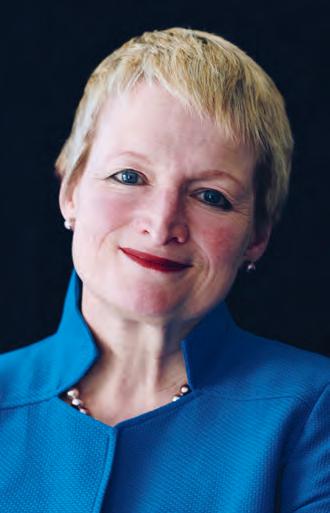
handling issues by 9% – suggesting significant potential for enhancement in human-centered work.
The key insight is that AI’s impact on services may not be about replacing human judgment and creativity, but augmenting human capacity to create meaning and connection. Rather than seeing cultural activities as drains on economic productivity, we might understand them as the ultimate output of a truly productive society.
As Perez notes, “the sociopolitical form we give to technology will define whether we enter a golden age.” The choice isn’t predetermined. We could use AI to create a hyper-quantified society where every human interaction is optimized for measurable outcomes. Or we could deploy it to create the efficiency that enables a flourishing of the unmeasurable aspects of human experience.
Leaders navigating this transition need to hold two seemingly contradictory truths: we must drive measurable productivity improvements while simultaneously creating space for the immeasurable aspects of human flourishing that define golden ages. This means rethinking success metrics to include cultural vitality and community engagement alongside traditional economic indicators. It means investing in the infrastructure of human development – not just broadband and data centers, but concert halls and community gardens.
Most importantly, it means recognizing that the ultimate test of any technological revolution isn’t whether it makes our processes more efficient, but whether it makes our lives more fully human. True productivity includes producing the kind of society we actually want to live in.
The question is not whether AI will boost productivity – the evidence suggests it will. It is whether we’ll use that productivity to create more widgets or more wonder.
Women in sport are not just catching up – they’re taking over
Writing Matthew Butler-Adam & Leela Srinivasan
In the 1960s, a young American runner named Kathrine Switzer signed up for the Boston Marathon under the name KV Switzer. She wasn’t disguising her identity to cheat – she was simply trying to run. At the time, women were barred from officially competing. During the race, a male official infamously tried to push her off the course. The images are now iconic: Switzer, resolute, pushing forward as the patriarchy literally claws at her jersey.
Switzer’s leadership through defiance did more than change marathon rules; it symbolized the broader struggle for women in sport. For decades, women athletes were seen as novelties, their accomplishments diminished or ignored entirely. Access to resources, media coverage and fair compensation was limited, at best. At worst, the environment was outright hostile. In 1972, the US passed a landmark federal law, Title IX, guaranteeing equal opportunity in educational sports – yet the needle still moved slowly.
Today, however, the air has changed – and leadership has played a critical role.
From exclusion to explosion
Consider the Women’s National Basketball Association (WNBA). For years, it was treated like the NBA’s little sister – tolerated rather
than celebrated. But now, the WNBA is not just surviving; it’s thriving. Through September 2025, WNBA viewership was up 34% across all national TV networks from the previous year, according to Nielsen data. Breakout stars like Caitlin Clark, Angel Reese, Sabrina Ionescu, and A’ja Wilson driving significant momentum. Clark, who joined the Indiana Fever as the number one draft pick in 2024, shattered college basketball records and brought an entirely new demographic to women’s hoops. Her social media following exceeds five million and her jersey became the highest-selling WNBA jersey of all time – before she even played a professional game.
Clark isn’t just an athlete – she’s a leader. She models what Amy Edmondson calls teaming: the dynamic process of leading within fluid, often temporary, team structures. On and off the court, Clark demonstrates how adaptability, psychological safety, and inclusive communication enable high performance. These are hallmarks of modern leadership that extend beyond traditional hierarchies, resonating with a generation raised on collaboration. The same qualities are embodied by Kara Lawson, the Team USA head coach, who recently stepped into the role following a fiveseason resurgence with Duke’s women’s team.
The business world is taking note. Google, Nike and AT&T are just a few of the blue-chip companies investing heavily in the WNBA, which kicked off the 2025 season with a record 46 sponsors and is also opening up new sponsor categories like beauty (Glossier), contraceptives (Opill), and dating apps (Bumble). According to the WNBA, sponsorship is up 17% in reaction to a 170% rise in ESPN viewership; in 2024, the league also posted a 600% year-on-year increase in merchandise sales. Meanwhile, expansion is on the horizon, with new franchises in Toronto, Portland, Cleveland, Detroit and Philadelphia eager to follow in the footsteps of the Golden State Valkyries, whose inaugural season valuation of $500 million has made them the most valuable teams in all of women’s sports. Once considered a niche product, the WNBA is fast becoming a model for what modern, inclusive sports can look like – not only as entertainment, but as a proving ground for leadership innovation.
Globally, the story is similarly electric in women’s soccer, which 2024 research by Parity and SurveyMonkey showed to be the most popular sport among women’s sports fans in multiple markets, from Germany to Australia. The 2023 Fifa Women’s World Cup in Australia and New Zealand drew nearly 2 billion viewers, a dramatic jump from previous years. The Uefa Women’s Euro 2025 tournament, hosted by Switzerland, saw in-person attendances rise 14% on the 2022 tournament,


while in the UK, a peak audience of 16.2 million watched England’s Lionesses successfully defend their title against Spain – making the final the most-watched television moment of 2025 to date across all UK TV broadcasters.
Change is afoot in the US, too. The national team continues to command one of the most loyal fanbases in American sports: US fans of women’s soccer are 58% more likely to have made a purchase because of a brand’s sponsorship of women’s sports than fans of any other women’s sport. Growth isn’t limited to the international game, either. The club scene is just as dynamic. England’s Women’s Super League (WSL) has seen average attendances rise from 1,000 in 2018 to over 7,000 in 2024.
This isn’t only a story of commercial success. A 2022 study on elite women’s football published by researchers at Loughborough and Sheffield Hallam universities in the UK highlights how transformational leadership – characterized by idealized influence, inspirational motivation, intellectual stimulation and individualized consideration – is a defining feature of success. These leaders empower their teammates, embody shared values and inspire collective achievement. In a sport often seen through a masculine lens, these women are forging a different, deeply effective leadership paradigm.
Rising tides across the sports world
Beyond basketball and football, stories of progress abound. In tennis, women have long shared center stage thanks to icons like Billie Jean King, Serena Williams and Naomi Osaka. But newer players like Coco Gauff and Iga Swiatek are commanding global followings – and prizes that, at the grand slam tournaments at least, now match the men’s.
Motorsports is also shifting, although the road ahead remains long. F1 Academy, launched to develop women drivers, has seen exponential interest from sponsors and, critically, provides concrete inspiration for future drivers. At the Forbes Power Women’s Summit in September 2025, F1 Academy managing director Susie Wolff said, “Whenever I go to a kart track now, all these little girls come up to me and say, ‘Remember my name. I’m going to be racing in F1 Academy in ten years.’” Meanwhile, women’s mixed martial arts continue to soar, with stars like Amanda Nunes and Rose Namajunas headlining events and drawing massive pay-per-view numbers. Each of these athletes serves as a public-facing example of individual leadership: building resilience, owning one’s narrative, and influencing change.
In surfing, another tide is turning. The World Surf League (WSL) became the first global league to offer equal prize money to men and women in


2019. Since then, viewership for women’s heats has grown steadily. Jessi Miley-Dyer, the WSL’s head of competition and chief of sport, has led from the front, advocating for parity and performance. Under her leadership, events like the Pipeline Pro and Tahiti’s Teahupo’o have featured women competing in waves once deemed too dangerous for them. Spoiler alert: they didn’t just survive –they dominated.
And there’s more. The 2025 Women’s Rugby World Cup – hosted and won by England –smashed previous viewing records. In Australia and New Zealand, women’s rugby teams now enjoy TV deals once reserved exclusively for men’s competitions. Cricket is on the up, too: in India, the Women’s Premier League cricket tournament launched to strong ratings and high sponsorship interest. Even eSports are showing growth in women’s participation and viewership.
Everywhere you look, ceilings are cracking, and behind each breakthrough is a leader, a captain, a coach, or an organizer driving the movement.
The kind of leadership visible in the explosion of women’s sports aligns closely with Sim Sitkin’s Six
Domains of Leadership model, developed at Duke University. Sitkin proposes that effective leadership requires strength across six interdependent domains: personal, relational, contextual, inspirational, supportive and responsible. Leaders in women’s sports, like Miley-Dyer and others, are excelling, not just by inspiring performance, but by transforming the environments in which that performance happens. For example, Miley-Dyer doesn’t only rally athletes around a shared vision – she builds trust through authentic relationships, adapts to evolving cultural and institutional contexts, and takes personal responsibility for sustaining change. These are not traits limited to athletic leadership; they represent a broader, transferable leadership architecture capable of reshaping entire systems.
In women’s sports, this multi-domain model is not theoretical – it’s visible in action. When athletes speak out on pay equity (as WNBA athletes are doing at the time of writing), when teams cocreate inclusive cultures, or when league executives mobilize new audiences through digital platforms, they are enacting leadership across Sitkin’s six dimensions. Their success lies not in a single leadership style, but in an ability to lead holistically – balancing influence with integrity, vision with support, and ambition with accountability. As Sitkin emphasizes, lasting leadership impact comes from integrating these domains to generate alignment and trust. Women’s sports are proving this is not just possible, but powerful.
Underpinning the growth of women’s sport is a financial and cultural awakening. Capital is finally following the eyeballs and the enthusiasm. Deloitte has projected that women’s elite sports will be a $2.35 billion industry in 2025, more than double its size in 2023. Private equity firms like Sixth Street have invested over $125 million in women’s football ventures, while venture capitalists back women-focused media and merchandising platforms. Although men’s sports still command a greater media share, streaming platforms –liberated from legacy gatekeepers – are making women’s sports more widely accessible. Meanwhile, a small but growing cohort of companies are making bold financial bets across the women’s sports landscape, including Ally Financial (which in 2022 pledged to spend 50% of its sports-paid media dollars on women’s sports within five years) and Gainbridge (allocating 40% of its sports sponsorship dollars to women’s sports).
Yet it is not just corporations fueling this surge – it’s advocacy and leadership. Organizations like Parity, which connects brands with elite women
athletes, are creating direct pipelines between talent and sponsorship, providing athletes from a wide range of sports with much-needed supplemental income, while helping sponsors capitalize on the rapidly expanding business opportunity. With fans expressing higher-than-ever levels of trust in professional women athletes, women’s sports are not just a cause – they’re a lucrative category. The women’s sports ecosystem is rapidly adapting to this shift in framing, reflecting Sitkin’s call to move beyond idealized leadership styles to the actual work leaders do: mobilizing systems, building trust and aligning values with action.
Leaders in women’s sports are excelling, not just by inspiring performance, but by transforming the environments in which that performance happens
Sponsorship, long the Achilles heel of women’s sports, is becoming a growth engine. Brands are recognizing that women’s sports attract more diverse, engaged and socially conscious audiences. Families are attending events in higher numbers, seeing women’s leagues as safer and more inclusive. At a time when traditional sports face scrutiny over violence and toxic cultures, women’s leagues offer a compelling alternative: sport as a force for community and progress.
The fan base is changing too. Nielsen data shows Gen Z fans are more likely to follow women athletes than any previous generation. They value authenticity, equity and impact – and women’s leagues over-index in all three areas. These fans don’t just watch; they build movements. They engage, post, and elevate their heroes as cultural icons.
Still, barriers remain. Investment is growing, but it’s far from equal; sponsorship dollars and media coverage remain heavily skewed toward men’s leagues. But the tectonic plates are shifting. The question is no longer whether women’s sports can succeed, but how fast and how sustainably they can scale.
If current trends hold, by 2035 the top women’s leagues could rival men’s in sponsorship, viewership, and cultural significance. The product is thrilling. The athletes are world-class. And the demand is unmistakable. What makes this tipping point different is the leadership within: athletes, coaches, executives, and communities co-creating the future of sport.
Matthew
ButlerAdam is regional managing director, UK and EU, and head of London office, at Duke Corporate Education. Leela Srinivasan is CEO at Parity
As we look forward, let us not forget Switzer and the many who ran despite being told to stop. They didn’t just break barriers – they carved new highways. They emboldened today’s athletes to follow in their footsteps and plant seeds for the next generation. In their slipstream are also the women entrepreneurs, executives and founders scaling sports-tech startups, negotiating broadcast deals, and launching global campaigns. They’re not waiting for permission – they’re seizing the initiative. As Switzer herself once said: “Talent is everywhere, it only needs the opportunity.”

opportunities that arise? How do we pivot from permacrisis to permaopportunity?
Over the course of my career, I’ve evolved four techniques that help. They don’t solve everything – but they do help leaders limit risk and turn abundant threats into opportunities.
1Focus on the essentials, stay flexible
At Sanofi, our people are the priority: our backgrounds, our skills and our potential are the most precious resource. Talent development is what powers innovation in an R&D-driven biopharma leader – so, one of the first things I did when I joined was to work with the talent team to review and enhance our strategy for giving our people more opportunities to learn and grow.
Leaders need to get away from constant fire-fighting and focus on creating a sense of permaopportunity
Writing Audrey Clegg
My Dad trained in the US Air Force and remained a keen amateur pilot throughout his life. I remember flying with him in a single-engine Cessna when I was just 16. He’d shown me some of the basics, but one afternoon, he really surprised me.
“Ok Audrey,” he said. “It’s time you learned how to land this plane in an emergency. If anything happened to me, you’d need to get us down.”
He booked me on to an ‘emergency landings for non-pilots’ weekend course which turned out to be a great introduction to the most important thing in crisis management strategy: be prepared. With the rolling sense of crisis that seems now to be part of everyday corporate life, we all need to be prepared for ‘emergency landings’ – but that’s only the foundation. The big question for leaders is: how do we get away from firefighting and fearbased responses and start maximizing the strategic
We all need to be prepared for ‘emergency landings’ – but that’s only the foundation
What we developed was demanding and focused, but also flexible. We launched it in mid-2023 – but within six months, a major reorganization took place, creating a new business operations function that combined elements of commercial, finance, digital and people services in four hubs around the world. Fortunately, the seven talent principles we had chosen were compatible in many ways, which helped us navigate the change and scale up hiring. Today, we have a talent team of around 150 in the hubs, the majority of whom are new hires – and business operations has become a significant part of the delivery model for our team. The values and principles we had established prevented any elements of what was a big challenge from tipping into crisis.
The same is true of the healthcare support we give our people. Expectations are high, but so is the care we give. I recently met one of our marketing team in Mumbai, Isha Chaudhari. She had suffered vital organ failure due to a Covid complication and had to undergo a transplant.
“For four months, I was under strict medical monitoring at home,” Chaudhari told me. “It was so tough, maybe the toughest time of my life! But the one thing I did have was time. I could upskill for the next phase of my career.” With access to Sanofi’s learning resources, she studied business analytics, forecasting, modelling and corporate finance. Since coming back to work, she’s taken on gigs to build her skills, and moved from our specialty care division to vaccines. Chaudhari still has to take time out now and again for her health, but she gets the care she needs and comes back aiming higher. Moving across functions or businesses like Chaudhari is one of the best ways to build the skills and networks we need to turn threats into opportunity. We put the same care into supporting health and wellbeing for our teams and the institution as a whole. That means we can successfully navigate the organizational changes that are routine for large corporations today.
Freshen up with outside-in thinking
If you’re going to find innovative solutions in tough situations, getting insights from people outside your usual tribe is essential. Did you ever hear about the truck that got stuck under a bridge? Emergency workers debated whether to dismantle parts of the truck or chip away at parts of the bridge. But a kid walking past said, “Why don’t you just deflate the tyres?”
That kind of smart lateral thinking has been part of our DNA at Sanofi for years, but we are getting better and better at putting it center stage. Some years back, the organization was fragmented with a number of siloed brands. We were struggling to compete. So, in 2021, incoming chief executive Paul Hudson announced a seismic move: for the first time in our 50-year history, we would unite as a single organization under the Sanofi name.
Many employees felt deep allegiances to our legacy brands, many of which – such as Pasteur and Genzyme – had their own histories. We needed a gear shift: something new and radical, something participative.
The Paris Olympics in 2024 presented a unique opportunity. Every sponsor reaches their own agreement with the Games, and our terms were to receive the maximum number of opportunities for Sanofians to participate in delivering the Games: in fact, 85% of our internal budget for the Games would be spent on employee engagement. For a multinational with demanding shareholders and an ambitious R&D pipeline, this was an extraordinary investment decision.
It created the largest ever Olympic and Paralympic employee engagement program. More than 2,000 Sanofians from dozens of countries came to help run Paris 2024, and we worked with them to help them share the stories of their inspirational experiences.
That has really helped with one of our key talent and learning goals – to build employer brand. Our online Olympics campaign drove 4.5 million clicks and a 215% increase in conversion. Just as important, our sponsorship massively inspired our influencer community to share their stories both about the Games and, afterwards, about their experiences working at Sanofi.
In 2025, we hit our highest score to date in the Employer Brand Index, ranking above our key pharma competitors. The Paris Olympics played a big part in that.
The third strategy for turning crisis into opportunity is to look for openings where it is possible to push ahead with changes initially considered too radical. Many of us discovered during Covid how extreme situations open
our minds to what we previously thought was impossible. In 2019, I had been working with a number of colleagues to try to introduce the idea of gig working in an fast-moving consumer goods (FMCG) multinational. ‘Try before you buy’ is such a part of any FMCG launch, we hoped that the idea wouldn’t need too much of a sell-in. But many line managers in the business thought there was a risk of chaos. “Just search on the intranet and apply? Really? And HR wouldn’t be involved?,” asked many. “How do we keep track of productivity? What happens to the ‘day job’ when you’re also working a gig?” said others.
Look for openings where it is possible to push ahead with changes initially considered too radical
We knew that gig working was a great opportunity for people to experience different functions or roles, to upskill, and to help us meet business needs with different perspectives – a winwin-win. Yet, it was only when Covid left us with acute demands in some areas, and surplus of talent in others, that we were able to get the project launched.
Within six months, we had more than 1,000 people participating in gigs. That was way more than we anticipated – and it set a foundation for a profound shift in our working practices in the years ahead.
My final must-have for dealing with permacrisis is all about narrative. An ambitious and flexible talent and learning strategy is essential to ride the storms – but it will only get you so far if the storytelling that brings it to life doesn’t hit the mark.
One of the hardest and most important things is to put your audience first. What matters to your customer – what helps them get their job done – is as important in sales or digital as it is in HR. Whether we’re reporting on progress to the executive committee or interviewing early talent, we’ve got to have the right facts and a good story –and we’ve got to keep telling it.
Finding the right tone of voice and using everyday language is vital. I speak three languages if you count American and British English as different (a ‘yes’ in British often means ‘no’, after all!) But my third language is corporate. I know we need to synergize core competencies and leverage paradigm shifts with actionable insights – but talking about it like that will only get you so far, especially in crisis. That’s why we don’t say we have a tripartite career progression model. We say it “takes three to tango.”
To help us change the way we share stories, we’ve now given 5,000 Sanofi Influencers storytelling training. When they start out, the language is often corporate – but when we suggest they use the same style they would if talking to a
friend over coffee, the response they get goes way up. That’s what authentic stories do: they open hearts, build trust, and throw new light on tough problems.
When we were starting our Olympic volunteer program, I was on a Zoom with over 1,000 people. I was staying with my parents. In spite of my careful instructions, right when I’m ready to start my part of the launch presentation, Dad comes in and opens the fridge. Out falls a big box of blueberries – and they roll all over the floor.
By this point, I’m talking on the Zoom, fiercely signaling to Dad to leave ‘my office.’ But no, he picks up a broom and starts sweeping up, even reaching for the berries under my feet.
It was well-intentioned but, as I reflected later, isn’t that the worst way of handling a crisis? Focus only on your stuff; don’t think about the team; don’t communicate with anyone – or, in fact, actively ignore what they’re telling you. It’s the playbook for many leaders in the world today, and it makes any crisis a whole lot worse.
Storytelling sharpens our storylistening
When I put social media away for the day, I sometimes think back to my grandparents’ childhood in the 1910s and 1920s. There was no shortage of crises then: World War One, the flu epidemic of 1918 – which killed an estimated 50 million people – and then the Wall Street Crash of 1929. Four years later, US national income per capita was down 28%; it didn’t recover to 1929 levels for a full decade. In contrast, when it came to the global financial crisis of 2008, per capita income fell by only 5% and recovered within six years. And yet, no one then spoke of a permacrisis.
I think the difference today is the quantity and quality of news stories we hear. Perhaps the idea of ‘permacrisis’ is a product of how we think, because of the stories and opinions we feed on.
The science is clear: the way we measure impact – and drive profitability – in social media gives a preference to content that provokes strong reactions. Outrage gets more engagement. The result is that the most divisive, inflammatory voices get a bigger platform, and too much influence. Rethinking social media metrics is urgent but, in the meantime, we each have a responsibility to question what we read.
In fact, learning how to tell good stories is the best way to understand the tricks employed to tell bad ones – those that grab our attention by manipulating our emotions, promising easy solutions to complex problems, often scapegoating particular demographics, filling our feeds with fake news.
Storytelling is one of humanity’s oldest tools. It shaped the evolution of our brains, it defines who


we are, where we’ve come from and where we’re going. The stories we tell ourselves and each other can either build our emotional intelligence and guide us through the storms we face so frequently – or wreck the foundations we have worked for so long to build.
Clegg is chief talent and learning officer at Sanofi
It’s all too easy to let others dictate the narratives that determine our lives. But fortunately, we have a choice. We can rewrite the stories we tell so that they support us as individuals, as teams and as businesses – no matter what challenges or crises come our way.
South America’s fifth-largest economy is on track for healthy growth – but will it be derailed by political instability after the ousting of an unpopular president, amid corruption allegations and growing unrest?

Land area
1,285,216 sq km
(496,225 sq mi)
Population
34.2 million
Capital
Lima (pop. 11.5 million)
GDP
US$289.2 billion (2024)
Economic record
+3.3% (2024)
Forecast
+4% (Economy Ministry forecast for 2025)
GDP per capita (PPP)
US$8,452 (2024)
Currency
Peruvian Sol (PEN)
PEN S/1 = US$0.29 (Oct 2025)
Unemployment 6%
Life expectancy
Women 80 years
Men 75 years
Official languages
Spanish, Quechua, Aymara

28.5%
Share of Peru’s GDP accounted for by its exports. It is the world’s third largest copper producer
1.36%
Inflation in Peru, September 2025 – far lower than many other countries in the region

140,000
Rainforest hectares cleared by gangs amid a gold rush
2
US firms Chevron and Westlawn granted access to Peru for hydrocarbon exploration in September 2025
$4,000
The record price of gold per ounce, in October


70,000
People killed during the Shining Path and Tupac Amaru insurgencies between 1980-2000
20,000
People disappeared during the insurgencies
600+
Judicial proceedings involving ex-military, police and militia could be halted under a controversial amnesty

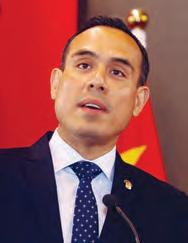
The evil that afflicts us in this moment is insecurity in the streets, the criminal gangs… They are today our enemies, and, as enemies, we must declare war on nationwide crime
Newly sworn-in President José Jeri pledges action on crime, October 2025
This legislation breaches international standards… The State must urgently reverse these setbacks in Peru’s pursuit of justice and reconciliation
UN human rights experts criticize the amnesty announced in August 2025
We demand a life without fear
Anti-government protestors on the “Gen Z march” in Lima, September 2025

2%
Approval ratings for President Dina Boluarte (above) prior to her ousting and replacement by Congress leader, José Jeri
2
Boluarte controversially doubled her salary in July 2025. She also faced numerous allegations of corruption
35,500
Boluarte’s increased monthly salary, in soles (equivalent to $10,000)
122
Number of lawmakers in Peru’s Congress, out of 130, who voted to remove Boluarte from the presidency in early October 2025

12 April 2026
Scheduled date of Peru’s next general elections
One of Duke Corporate Education’s flagship events of 2025 saw a stellar line-up congregate in Johannesburg to discuss how women are shaping the future of business
Writing Patrick Woodman
The latest landmark conference in Duke CE’s eye-catching events program took place in South Africa in August 2025. An audience drawn from across a range of leading organizations gathered at the Women Leading Change summit to hear a host of speakers from business, media and academia sharing insights on the challenges facing women in leadership –and to explore how women’s leadership is changing society for the better.
A series of leaders offered delegates inspirational words on the capacity of women in leadership to create change. “In every revolution, there is a whisper before the roar,” said Annika Larsen, news anchor at eNews Channel Africa (ENCA) opening the show. “A seed before the forest, a spark before the blaze. We are that whisper, that seed, that spark.”
Basetsana Kumalo, author and venture capitalist at Basetsana Women Investment Holdings, was equally powerful. “We are architects of tomorrow,” the former Miss South Africa said, “building with bricks of resilience and mortar of hope.”
Cisco Africa senior director, Charmaine Houvet, also spoke of resilience when she reminded delegates that – while huge challenges remain –vast progress has been made. “We have walked through storms that tried to break us,” she said. “Yet here we stand, unbroken, turning scars into symbols – and fear into fuel.”
One of the day’s highlights saw a touching tribute paid to the ‘First Mother,’ Zanele Mbeki. A feminist activist, Women’s Development Bank founder and former South African first lady, Mbeki was hailed as a leader, mentor, mother and institution builder. “You’ve lit the path of so many successful women in this country,” said Sindi Mabosa-Koyana, co-founder of the African Women Chartered Accountants Organization (AWCA). “We stand on your shoulders… We love you.”
Mbeki has “a rare gift of making people feel seen, heard, valued and encouraged professionally,” added Sharmla Chetty, Duke CE’s chief executive. “She reminds us that the future belongs to those that remain curious, adaptable and hopeful.”
Chetty herself recently received the Woman of Substance award from the AWCA. It was, she told guests, a humbling moment. “It speaks deeply to me because my own journey, like many of yours, has been possible because of courage.” (See page 9 for her column on courageous leadership.)
Creating change means unlearning old ways of working
As delegates were reminded, courage takes many forms: it is required not only for confronting deep social injustices, but for handling sensitive moments within an organization both candidly and kindly. “The most courageous thing you can ever do is to be honest with a team member and tell them where they are developmentally,” said Duke University executive vice president Daniel Ennis. “That courage and leadership is about developing, cultivating, investing and nurturing others and showing the ultimate act of love – the hard messages.”
Elsewhere, the growing impact of AI was a major theme. Fran Katsoudas, executive vice president and chief people, policy & purpose officer at Cisco, assured delegates that despite the huge advances in AI capabilities, core human qualities must remain preeminent. People must remain at the center of how we navigate disruption, said Katsoudas, and guide how we use AI. Bold leadership is required, with inclusion at its heart. “There’s a tremendous opportunity with AI, but a tremendous risk if we don’t include everyone,” said Katsoudas.
She urged leaders to commit to preparing their people and communities for what’s next. “If, at the end of the day, you demonstrate that you care for one another – that we want people to be the best they can be – it changes the environment and makes us better,” she said. Learning agility is emerging as a defining leadership skill. “The ability to constantly learn, reframe, and think about things differently, is essential,” added Katsoudas. “The learning we take on and the learnings we share will give us the ability to truly architect the future.” That is a huge responsibility – one that

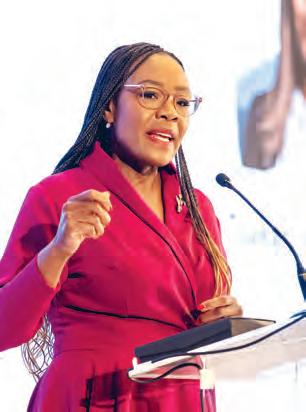



demands leaders to design progress thoughtfully, she cautioned. “This is the moment where we have to architect how we want to use AI. Ultimately, it’s about staying true to our values as we embrace this technology.”
The capacity of women leaders to shape a better future – and the strategies being pursued by companies to achieve greater equality – were also on the agenda.
Rizwana Butler, HR executive at Capitec, advocated a leadership model based on “humanness,” not command and control – which remains all too common. “The leadership models of today are based on power… on competition,” she said. “What the world needs is an opportunity for us to be more caring, to be more compassionate; for us to be working together despite our differences. That’s something that we as women are equipped to do.” The benefits will be widely felt, she added. “It’s not just about a better us and a better community. It’s for a better world.”
Taelo Mojapelo, chief executive of BP South Africa, revealed that more than half its leadership team are now women. Such “significant strides”
Above (clockwise from top left) Nolitha Fakude; conference panelists; Duke CE’s Sharmla Chetty; Cisco’s Fran Katsoudas; Zanele Mbeki receiving tributes; South Africa’s Audior General, Tsakani Maluleke; Mastercard trio Bryan Habana, Michael Fraccaro and Lucrecia Borgonovo


were possible only with carefully-crafted recruitment, mentorship and sponsorship, she explained. “We’ve got a diverse recruitment panel,” she said, “making sure that as we recruit we are very clear about what capabilities we want to bring into the organization, making sure that we bring in competent potential, and that we are able to then develop [that talent] with mentorship opportunities, training opportunities – some of which take place with Duke CE right here.”
Creating change means unlearning old ways of working – including for women themselves, as delegates heard from Shirley Machaba, CEO, South Africa and regional senior partner, Southern Africa, at PWC. “There’s lots of aspects that women must ‘unlearn,’” she warned. “Why? Because of the way we grew up, the way we have been.”
New contexts demand new ways of doing things, she explained. “You find that now you are leading, you know partners who trained you, and you end up not having a voice. You are scared of speaking up,” said Machaba.
Patrick Woodman is editor of Dialogue
The challenge for women in leadership is clear, she concluded. “It’s about reinventing yourself, reimagining the possible – and making sure that your mindset is very different.”
Here’s how leaders can see work in its truest form
Executives rarely lack data. Dashboards, KPIs, benchmarks: the modern C-suite lives in metrics. Yet one of the most crucial elements of performance and transformation remains strangely opaque: the reality of what work actually happens inside our organizations.
We know job titles and role descriptions. We know costs per head, attrition rates and productivity ratios. But these abstractions often conceal more than they reveal. They create a comforting fiction: that work is neatly contained within roles, hierarchies and functions.
In truth, work lives in tasks: the emails written, the client calls made, the spreadsheets updated, the insights developed, the experiments run. It is at this atomic level of work that we start to understand both value creation and waste. Indeed, the entire shift toward skills-based organizations is built on the deconstruction of jobs into tasks.
This is the essence of Task Intelligence: the capacity to see, map – and make sense of – work at the level it is actually delivered.
The strategic shift from jobs to tasks
For decades, we built structures around jobs – bundles of responsibilities formalized through contracts and titles, arranged into hierarchies. But in an age defined by agility, automation and shifting skills, those bundles are fraying.
AI doesn’t take jobs; it takes tasks. Automation targets repeatable activities, not whole professions. Likewise, reskilling must begin with an understanding of what people do, not what their titles imply.
Task Intelligence is the missing link between traditional operating models

and the more adaptive organizations now required. It complements concepts like skills-based organizations, polymorphic structures and organizational oscillation. All point to the same realization: the future of work demands that we unbundle, reconfigure, and continually reimagine how value flows through systems. When leaders begin to view their organization through tasks, rather than jobs, several things become possible.
Clarity of value Which activities genuinely align with strategy, and which are relics or distractions?
Liberated capacity Studies suggest 20–30% of effort is spent on low-value work. Task Intelligence surfaces it, creating opportunities to redeploy without blunt cost-cutting.
Future readiness As AI advances, knowing the distribution of tasks helps leaders plan thoughtfully. Which should be automated, augmented, or remain deeply human?
Human engagement People thrive when time is spent on meaningful contributions.
Removing low-value tasks is not just efficiency; it is cultural.
For systems thinkers, Task Intelligence is a natural progression. It traces flows of energy, effort and attention through a living organization. If we see the organization as a dynamic system oscillating between expansion and consolidation, continually morphing to meet new challenges, then tasks are the currents within it. They show where the flow is smooth, where it eddies, where it is blocked.
Traditional operating models provide the scaffolding: roles, divisions, reporting lines. Task Intelligence reveals the movement within: the lived reality of how work gets done. Only by seeing both can leaders redesign for resilience. It is not about surveillance or atomizing work into soulless spreadsheets. It is about surfacing patterns, creating a shared language of value, and enabling evidence-based choices.
Practical steps often begin with lightweight mapping – surveys, digital tools, or workshops capturing how time and effort are distributed across key roles. From there, sharper questions follow. Which tasks should we stop? Which should we streamline or automate? Which should we amplify and invest in because they create disproportionate value?
The answers rarely demand wholesale role rewrites. Instead, they create a living basis for adaptation. Leaders can reallocate, reimagine and redeploy with confidence.
Ultimately, Task Intelligence is less about technology than perception. It teaches us to see organizations not as static arrangements of jobs, but as dynamic flows of tasks. Once that perceptual shift occurs, the possibilities for reimagining work – and building more adaptive, humane, and future-ready enterprises –expand dramatically.
Perry Timms is founder and chief energy officer of PTHR, a consultancy aiming to create better businesses for a better world. He is a TEDx speaker, top-selling author, and a member of HR Magazine’s Most Influential Hall of Fame
A new book argues that we’ve forgotten the importance of how we make things
We live in a world where manufacturing is both everywhere and invisible.
Tim Minshall’s Your Life is Manufactured: How We Make Things, Why It Matters and How We Can Do It Better (Faber, 2025) sets out to make it visible again.
Minshall, a Cambridge professor of innovation, is well placed to tackle the task. He writes with clarity and curiosity, offering a wide-ranging tour through the systems and infrastructures that underpin modern life. The book’s first achievement is to reframe manufacturing. For Minshall, it is not simply about factories and assembly lines, but about
Ignore manufacturing and we risk losing sight of the very driver of long-term growth

transforming inputs into outputs through people, process and ingenuity. A blacksmith, a hospital “making healthy people,” and a gigafactory producing batteries all fit his broad frame. This perspective matters: it reminds us that manufacturing is not a relic of the past, but the enduring foundation of prosperity, innovation and community.
Minshall also challenges the outdated image of the factory as grim and low status. Factory jobs often pay above the national average, provide skilled careers and anchor local economies. Switzerland and Singapore – global leaders in manufacturing – show how closely it is linked to innovation and resilience. Ignore manufacturing, Minshall suggests, and we risk losing sight of the very driver of long-term growth.
The book’s most compelling sections explore globalization and its discontents. Cheap shipping and hyper-specialization have produced supply chains that are economically efficient, but dangerously fragile. Minshall illustrates this with vivid stories: Scottish fish sent to China for filleting before returning to UK supermarkets; the chaos caused by a single container ship blocking the Suez Canal; the vulnerabilities exposed by Covid-19. His point is not that self-sufficiency is the answer, but that disconnection from production leaves societies exposed in crises, weakens innovation, and worsens environmental damage.
Sustainability runs throughout the book. Manufacturing, as it stands, is harming the planet. Yet Minshall highlights promising countertrends: the circular economy, product-as-a-service models, digital twins that allow safer and
leaner design, and the use of real-time data to drive efficiency. He treats more radical ideas, like “net-positive” manufacturing that actually improves the environment, with caution, recognizing them as aspirational rather than imminent.
His skepticism extends to the notion of a Fourth Industrial Revolution. While some hail robotics, AI and the Internet of Things as a fundamental break with the past, Minshall argues that manufacturing change is typically incremental, fragmented and uneven. History suggests we only recognize such revolutions in retrospect. Executives should resist chasing buzzwords and rather plan for steady, long-term adaptation.
The book is full of sharp details. Virtually all the switches in the world’s kettles are made on the Isle of Man; slowing container ships by 20% could cut their carbon emissions by a third. This makes the abstract tangible, and illustrates how small shifts can create large impacts. Yet Minshall is clear that progress toward cleaner, smarter, more resilient manufacturing is happening too slowly to meet urgent environmental challenges. If the book has a limitation, it is that it leans heavily on market-driven solutions, giving less attention to the political action that may be required to accelerate change. Those seeking a critique of government and regulation might look elsewhere.
Nevertheless, Your Life is Manufactured is an important contribution. It reminds us that every object we use embodies a story of transformation, and that how we manufacture will shape not only economies, but communities and the planet itself.

Your Life is Manufactured: How We Make Things, Why It Matters and How We Can Do It Better
Tim Minshall (Faber)
An old folk tale reminds us that true power resides in simple human connection
What comes to mind when you hear the word extraordinary? Maybe it’s astronauts traveling the vast unknown, pushing the boundaries of human exploration. Perhaps it’s Olympians on the world stage, competing in moments that define history. Or maybe it’s a priceless work of art that captures emotions in ways that words can’t.
These rare feats, which seem distant from everyday life, are the kinds of things we generally associate with greatness. But what if there is always something extraordinary around us that we mislabel as ordinary? What if extraordinary isn’t so rare? What if it is part of our everyday lives? If it is, how can we shift our perspective to see it more clearly?
A simple tale holds a deep truth. In the Stone Soup story, a traveler came upon a village. Weary and hungry, he asked a villager for food. They replied, “We are poor. We have nothing.”
The traveler had an idea. He called the villagers together and told them to bring a big pot. Then he pulled out a stone from his pocket. “It’s a magic stone. It’ll make us good soup. But first, bring to the pot whatever you find in your cupboards.” One villager brought a few carrots; another, leftover spices. One by one, they put in what they had – and what resulted was the most delicious soup.
I think what made it delicious wasn’t just that it tasted good. It wasn’t just about the ingredients. It was that they made it together – each person had a hand in creating the soup – and they enjoyed it together. The power is in the connection.
This is true of life and leadership. None of us has all the ingredients or all the answers. But each of us has a unique set of experiences, leading to unique perspectives. Sharing our perspective with others allows for the co-creation of something innovative and exciting.
Hans Christian Andersen wrote movingly that, “The whole world is a series of miracles, but we’re so used to them that we call them ordinary things.”
In our everyday lives, let’s see each other, learn from each other, and co-create together. The real magic is in us all
This mistake is perhaps most commonly made about people. Just think what it takes for any one person to come to being: the ancestors that went before us; the experiences that gave us wisdom and brought us to the present moment; the struggles encountered and the victories earned. The reality is that we are all extraordinary.
With each interaction and relationship built, we are making stone soup. Whether it is at work, in a restaurant, or even in our own homes, we are surrounded by, and participate in, something extraordinary every day: human connection. We must be intentional in our rediscovery of the extraordinary in each other, and remember always that although we may have amazing achievements, they are merely things we’ve done: they are not the entirety of who we are.
In an age of technological feats, we can better leverage AI by doubling down on what makes us human. It’s the capability to collaborate and cultivate friendships. It’s about fostering and using our virtue superpowers, such as wisdom, courage, vulnerability and authenticity. It’s about the capacity for hope. Leading in today’s environment requires us to see each other as extraordinary people. It is part of rethinking power, and becoming an influential leader capable of moving people to achieve great things. The starting point, before anything else, is to understand your teammates as individual, remarkable stories.
In our organizations and everyday lives, let’s see each other, learn from each other, and co-create together. The real magic is in us all.
Sanyin Siang is a Pratt School of Engineering professor and leads the Fuqua/ Coach K Center on Leadership & Ethics at Duke University























MEGAN REITZ Professor of Leadership and Dialogue at Hult International Business School













PAUL (PABLO) ETTINGER Chairman of TALENTBANQ and one of the founding team of Caffe Nero














“This concise and thoughtful volume masterfully demonstrates the power of the leader who shows up mindfully, with clarity, calmness, compassion and courage. It condenses a huge body of wisdom into an original and accessible framework, with tools and practical advice to improve both leadership skill and life fulfilment.”
“This is an immensely valuable book for anyone who would like to understand what good leadership behaviours look like and would like to improve their own leadership.”






“Sally-Anne’s book captures an important nuance of leadership through storytelling and blends her experience with a wealth of practical guidance.”
LARISSA HARRISON Global HR Director






























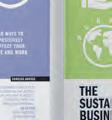











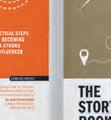










SMART THINKING AND SELF-DEVELOPMENT FOR A NEW GENERATION
• Dynamic and practical
• Concise and to the point
• Clever, smart and savvy advice
• Relevant to all levels of readers – from students to CEOs
• Appeals to different generations and age groups





















































Publisher: LID PUBLISHING (info@lidpublishing.com) Distributor: HACHETTE UK DISTRIBUTION www.lidpublishing.com/product-category/concise-advice-series